
ChatGLM3
ChatGLM3 series: Open Bilingual Chat LLMs | 开源双语对话语言模型
Stars: 12779
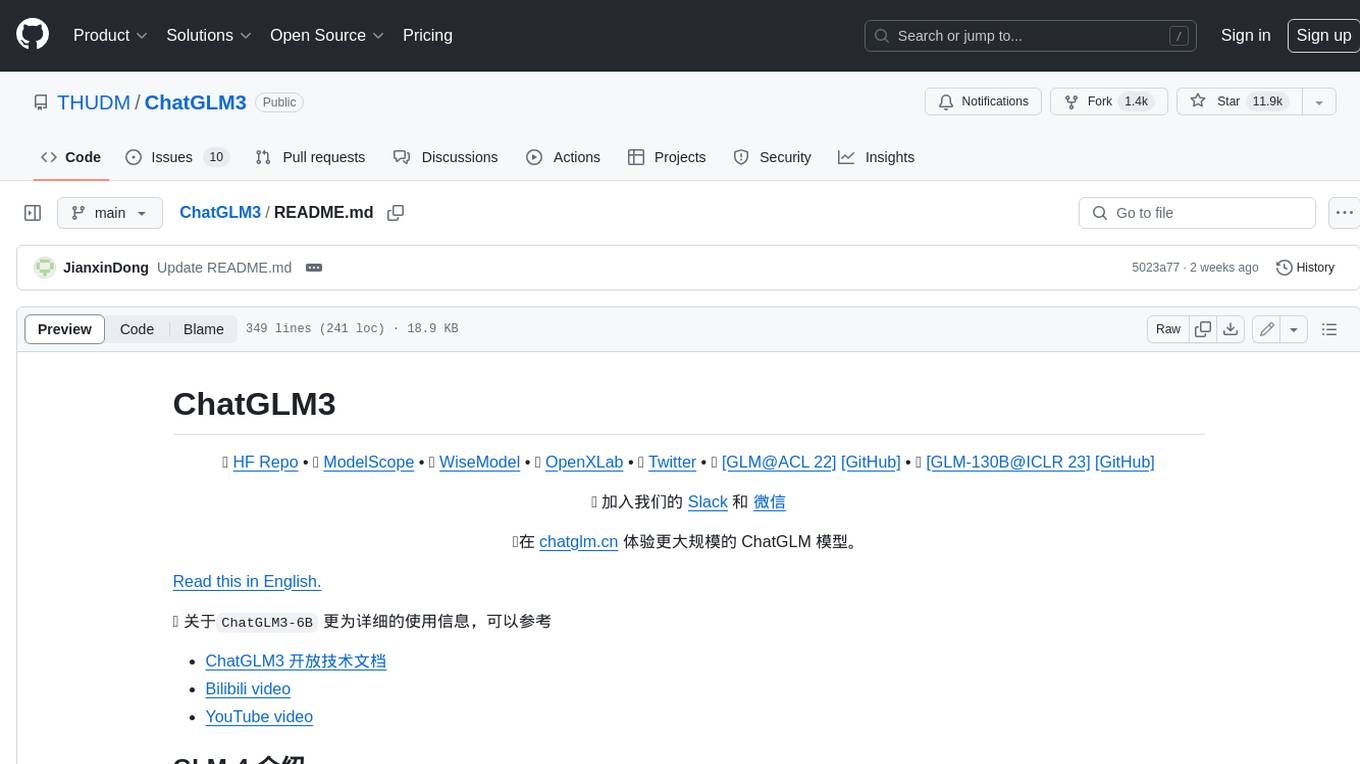
ChatGLM3 is a conversational pretrained model jointly released by Zhipu AI and THU's KEG Lab. ChatGLM3-6B is the open-sourced model in the ChatGLM3 series. It inherits the advantages of its predecessors, such as fluent conversation and low deployment threshold. In addition, ChatGLM3-6B introduces the following features: 1. A stronger foundation model: ChatGLM3-6B's foundation model ChatGLM3-6B-Base employs more diverse training data, more sufficient training steps, and more reasonable training strategies. Evaluation on datasets from different perspectives, such as semantics, mathematics, reasoning, code, and knowledge, shows that ChatGLM3-6B-Base has the strongest performance among foundation models below 10B parameters. 2. More complete functional support: ChatGLM3-6B adopts a newly designed prompt format, which supports not only normal multi-turn dialogue, but also complex scenarios such as tool invocation (Function Call), code execution (Code Interpreter), and Agent tasks. 3. A more comprehensive open-source sequence: In addition to the dialogue model ChatGLM3-6B, the foundation model ChatGLM3-6B-Base, the long-text dialogue model ChatGLM3-6B-32K, and ChatGLM3-6B-128K, which further enhances the long-text comprehension ability, are also open-sourced. All the above weights are completely open to academic research and are also allowed for free commercial use after filling out a questionnaire.
README:
🤗 HF Repo • 🤖 ModelScope • 🤖 WiseModel • 🧰 OpenXLab • 🐦 Twitter • 📃 [GLM@ACL 22] [GitHub] • 📃 [GLM-130B@ICLR 23] [GitHub]
📍在 chatglm.cn 体验更大规模的 ChatGLM 模型。
📔 关于ChatGLM3-6B 更为详细的使用信息,可以参考
我们已经发布最新的 GLM-4 模型,该模型在多个指标上有了新的突破,您可以在以下两个渠道体验我们的最新模型。
-
GLM-4 开源模型 我们已经开源了 GLM-4-9B 系列模型,在各项指标的ce是上有明显提升,欢迎尝试。
-
智谱清言 体验最新版 GLM-4,包括 GLMs,All tools等功能。
-
API平台 新一代 API 平台已经上线,您可以直接在 API 平台上体验
GLM-4-0520、GLM-4-air、GLM-4-airx、GLM-4-flash、GLM-4、GLM-3-Turbo、CharacterGLM-3,CogView-3等新模型。 其中GLM-4、GLM-3-Turbo两个模型支持了System Prompt、Function Call、Retrieval、Web_Search等新功能,欢迎体验。 -
GLM4 API 开源教程 GLM-4 API教程和基础应用,欢迎尝试。 API相关问题可以在本开源教程疑问,或者使用 GLM-4 API AI助手 来获得常见问题的帮助。
ChatGLM3 是智谱AI和清华大学 KEG 实验室联合发布的对话预训练模型。ChatGLM3-6B 是 ChatGLM3 系列中的开源模型,在保留了前两代模型对话流畅、部署门槛低等众多优秀特性的基础上,ChatGLM3-6B 引入了如下特性:
- 更强大的基础模型: ChatGLM3-6B 的基础模型 ChatGLM3-6B-Base 采用了更多样的训练数据、更充分的训练步数和更合理的训练策略。在语义、数学、推理、代码、知识等不同角度的数据集上测评显示,* ChatGLM3-6B-Base 具有在 10B 以下的基础模型中最强的性能*。
- 更完整的功能支持: ChatGLM3-6B 采用了全新设计的 Prompt 格式 ,除正常的多轮对话外。同时原生支持工具调用(Function Call)、代码执行(Code Interpreter)和 Agent 任务等复杂场景。
- 更全面的开源序列: 除了对话模型 ChatGLM3-6B 外,还开源了基础模型 ChatGLM3-6B-Base 、长文本对话模型 ChatGLM3-6B-32K 和进一步强化了对于长文本理解能力的 ChatGLM3-6B-128K。以上所有权重对学术研究完全开放 ,在填写 问卷 进行登记后亦允许免费商业使用。
ChatGLM3 开源模型旨在与开源社区一起推动大模型技术发展,恳请开发者和大家遵守 开源协议 ,勿将开源模型和代码及基于开源项目产生的衍生物用于任何可能给国家和社会带来危害的用途以及用于任何未经过安全评估和备案的服务。目前,本项目团队未基于 ChatGLM3 开源模型开发任何应用,包括网页端、安卓、苹果 iOS 及 Windows App 等应用。
尽管模型在训练的各个阶段都尽力确保数据的合规性和准确性,但由于 ChatGLM3-6B 模型规模较小,且模型受概率随机性因素影响,无法保证输出内容的准确。同时模型的输出容易被用户的输入误导。* 本项目不承担开源模型和代码导致的数据安全、舆情风险或发生任何模型被误导、滥用、传播、不当利用而产生的风险和责任。*
| Model | Seq Length | Download |
|---|---|---|
| ChatGLM3-6B | 8k | HuggingFace | ModelScope | WiseModel | OpenXLab |
| ChatGLM3-6B-Base | 8k | HuggingFace | ModelScope | WiseModel | OpenXLabl |
| ChatGLM3-6B-32K | 32k | HuggingFace | ModelScope | WiseModel | OpenXLab |
| ChatGLM3-6B-128K | 128k | HuggingFace | ModelScope| OpenXLab |
请注意,所有模型的最新更新都会在 Huggingface 率先发布。 ModelScope 和 WiseModel 由于没有与 Huggingface 同步,需要开发人员手动更新,可能会在
Huggingface 更新后一段时间内同步更新。
以下优秀开源仓库已经对 ChatGLM3-6B 模型深度支持,欢迎大家扩展学习。
推理加速:
- chatglm.cpp: 类似 llama.cpp 的量化加速推理方案,实现笔记本上实时对话
- ChatGLM3-TPU: 采用TPU加速推理方案,在算能端侧芯片BM1684X(16T@FP16,内存16G)上实时运行约7.5 token/s
- TensorRT-LLM: NVIDIA开发的高性能 GPU 加速推理方案,可以参考此 步骤 部署 ChatGLM3-6B 模型
- OpenVINO: Intel 开发的高性能 CPU 和 GPU 加速推理方案,可以参考此 步骤 部署 ChatGLM3-6B 模型
高效微调:
- LLaMA-Factory: 优秀易上手的高效微调框架。
应用框架:
-
LangChain-Chatchat: 基于 ChatGLM 等大语言模型与 Langchain 等应用框架实现,开源、可离线部署的检索增强生成(RAG)大模型知识库项目。
-
BISHENG: 开源大模型应用开发平台,赋能和加速大模型应用开发落地,帮助用户以最佳体验进入下一代应用开发模式。
-
RAGFlow: RAGFlow 是一款基于深度文档理解构建的开源 RAG(Retrieval-Augmented Generation)引擎。可为各种规模的企业及个人提供一套精简的 RAG 工作流程,结合大语言模型(LLM)针对用户各类不同的复杂格式数据提供可靠的问答以及有理有据的引用。
我们选取了 8 个中英文典型数据集,在 ChatGLM3-6B (base) 版本上进行了性能测试。
| Model | GSM8K | MATH | BBH | MMLU | C-Eval | CMMLU | MBPP | AGIEval |
|---|---|---|---|---|---|---|---|---|
| ChatGLM2-6B-Base | 32.4 | 6.5 | 33.7 | 47.9 | 51.7 | 50.0 | - | - |
| Best Baseline | 52.1 | 13.1 | 45.0 | 60.1 | 63.5 | 62.2 | 47.5 | 45.8 |
| ChatGLM3-6B-Base | 72.3 | 25.7 | 66.1 | 61.4 | 69.0 | 67.5 | 52.4 | 53.7 |
Best Baseline 指的是截止 2023年10月27日、模型参数在 10B 以下、在对应数据集上表现最好的预训练模型,不包括只针对某一项任务训练而未保持通用能力的模型。
对 ChatGLM3-6B-Base 的测试中,BBH 采用 3-shot 测试,需要推理的 GSM8K、MATH 采用 0-shot CoT 测试,MBPP 采用 0-shot 生成后运行测例计算 Pass@1 ,其他选择题类型数据集均采用 0-shot 测试。
我们在多个长文本应用场景下对 ChatGLM3-6B-32K 进行了人工评估测试。与二代模型相比,其效果平均提升了超过 50%。在论文阅读、文档摘要和财报分析等应用中,这种提升尤为显著。此外,我们还在 LongBench 评测集上对模型进行了测试,具体结果如下表所示
| Model | 平均 | Summary | Single-Doc QA | Multi-Doc QA | Code | Few-shot | Synthetic |
|---|---|---|---|---|---|---|---|
| ChatGLM2-6B-32K | 41.5 | 24.8 | 37.6 | 34.7 | 52.8 | 51.3 | 47.7 |
| ChatGLM3-6B-32K | 50.2 | 26.6 | 45.8 | 46.1 | 56.2 | 61.2 | 65 |
首先需要下载本仓库:
git clone https://github.com/THUDM/ChatGLM3
cd ChatGLM3然后使用 pip 安装依赖:
pip install -r requirements.txt
- 为了保证
torch的版本正确,请严格按照 官方文档 的说明安装。
我们提供了一个集成以下三种功能的综合 Demo,运行方法请参考综合 Demo
- Chat: 对话模式,在此模式下可以与模型进行对话。
- Tool: 工具模式,模型除了对话外,还可以通过工具进行其他操作。
- Code Interpreter: 代码解释器模式,模型可以在一个 Jupyter 环境中执行代码并获取结果,以完成复杂任务。
可以通过如下代码调用 ChatGLM 模型来生成对话:
>> > from transformers import AutoTokenizer, AutoModel
>> > tokenizer = AutoTokenizer.from_pretrained("THUDM/chatglm3-6b", trust_remote_code=True)
>> > model = AutoModel.from_pretrained("THUDM/chatglm3-6b", trust_remote_code=True, device='cuda')
>> > model = model.eval()
>> > response, history = model.chat(tokenizer, "你好", history=[])
>> > print(response)
你好👋!我是人工智能助手
ChatGLM3 - 6
B, 很高兴见到你, 欢迎问我任何问题。
>> > response, history = model.chat(tokenizer, "晚上睡不着应该怎么办", history=history)
>> > print(response)
晚上睡不着可能会让你感到焦虑或不舒服, 但以下是一些可以帮助你入睡的方法:
1.制定规律的睡眠时间表: 保持规律的睡眠时间表可以帮助你建立健康的睡眠习惯, 使你更容易入睡。尽量在每天的相同时间上床, 并在同一时间起床。
2.创造一个舒适的睡眠环境: 确保睡眠环境舒适, 安静, 黑暗且温度适宜。可以使用舒适的床上用品, 并保持房间通风。
3.放松身心: 在睡前做些放松的活动, 例如泡个热水澡, 听些轻柔的音乐, 阅读一些有趣的书籍等, 有助于缓解紧张和焦虑, 使你更容易入睡。
4.避免饮用含有咖啡因的饮料: 咖啡因是一种刺激性物质, 会影响你的睡眠质量。尽量避免在睡前饮用含有咖啡因的饮料, 例如咖啡, 茶和可乐。
5.避免在床上做与睡眠无关的事情: 在床上做些与睡眠无关的事情, 例如看电影, 玩游戏或工作等, 可能会干扰你的睡眠。
6.尝试呼吸技巧: 深呼吸是一种放松技巧, 可以帮助你缓解紧张和焦虑, 使你更容易入睡。试着慢慢吸气, 保持几秒钟, 然后缓慢呼气。
如果这些方法无法帮助你入睡, 你可以考虑咨询医生或睡眠专家, 寻求进一步的建议。以上代码会由 transformers
自动下载模型实现和参数。完整的模型实现在 Hugging Face Hub
。如果你的网络环境较差,下载模型参数可能会花费较长时间甚至失败。此时可以先将模型下载到本地,然后从本地加载。
从 Hugging Face Hub 下载模型需要先安装Git LFS ,然后运行
git clone https://huggingface.co/THUDM/chatglm3-6b如果从你从 HuggingFace 下载比较慢,也可以从 ModelScope 中下载。
我们提供了一个微调 ChatGLM3-6B 模型的基础套件,可以用来微调 ChatGLM3-6B 模型。微调套件的使用方法请参考 微调套件。
 可以通过以下命令启动基于 Gradio 的网页版 demo:
可以通过以下命令启动基于 Gradio 的网页版 demo:
python web_demo_gradio.py可以通过以下命令启动基于 Streamlit 的网页版 demo:
streamlit run web_demo_streamlit.py网页版 demo 会运行一个 Web Server,并输出地址。在浏览器中打开输出的地址即可使用。 经测试,基于 Streamlit 的网页版 Demo 会更流畅。
运行仓库中 cli_demo.py:
python cli_demo.py程序会在命令行中进行交互式的对话,在命令行中输入指示并回车即可生成回复,输入 clear 可以清空对话历史,输入 stop 终止程序。
代码实现请参考 LangChain Demo。
关于工具调用的方法请参考 工具调用。
我们已经推出了 OpenAI / ZhipuAI 格式的 开源模型 API 部署代码,可以作为任意基于 ChatGPT 的应用的后端。 目前,可以通过运行仓库中的 api_server.py 进行部署
cd openai_api_demo
python api_server.py同时,我们也书写了一个示例代码,用来测试API调用的性能。
-
OpenAI 测试脚本:openai_api_request.py
-
ZhipuAI 测试脚本:zhipu_api_request.py
-
使用Curl进行测试
-
chat Curl 测试
curl -X POST "http://127.0.0.1:8000/v1/chat/completions" \
-H "Content-Type: application/json" \
-d "{\"model\": \"chatglm3-6b\", \"messages\": [{\"role\": \"system\", \"content\": \"You are ChatGLM3, a large language model trained by Zhipu.AI. Follow the user's instructions carefully. Respond using markdown.\"}, {\"role\": \"user\", \"content\": \"你好,给我讲一个故事,大概100字\"}], \"stream\": false, \"max_tokens\": 100, \"temperature\": 0.8, \"top_p\": 0.8}"- Standard openai interface agent-chat Curl 测试
curl -X POST "http://127.0.0.1:8000/v1/chat/completions" \
-H "Content-Type: application/json" \
-d "{\"model\": \"chatglm3-6b\", \"messages\": [{\"role\": \"user\", \"content\": \"37乘以8加7除2等于多少?\"}], "tools": [{"name": "track", "description": "追踪指定股票的实时价格",
"parameters": {"type": "object", "properties": {"symbol": {"description": "需要追踪的股票代码"}},
"required": []}},
{"name": "Calculator", "description": "数学计算器,计算数学问题",
"parameters": {"type": "object", "properties": {"symbol": {"description": "要计算的数学公式"}},
"required": []}}
], \"stream\": true, \"max_tokens\": 100, \"temperature\": 0.8, \"top_p\": 0.8}"- Openai style custom interface agent-chat Curl 测试(你需要实现自定义的工具描述脚本openai_api_demo/tools/schema.py的内容,并且将api_server.py中AGENT_CONTROLLER指定为'true'):
curl -X POST "http://127.0.0.1:8000/v1/chat/completions" \
-H "Content-Type: application/json" \
-d "{\"model\": \"chatglm3-6b\", \"messages\": [{\"role\": \"user\", \"content\": \"37乘以8加7除2等于多少?\"}], \"stream\": true, \"max_tokens\": 100, \"temperature\": 0.8, \"top_p\": 0.8}"该接口用于openai风格的自定义工具箱的自主调度。具有调度异常的自处理回复能力,无需另外实现调度算法,用户无需api_key。
- 使用Python进行测试
cd openai_api_demo
python openai_api_request.py如果测试成功,则模型应该返回一段故事。
默认情况下,模型以 FP16 精度加载,运行上述代码需要大概 13GB 显存。如果你的 GPU 显存有限,可以尝试以量化方式加载模型,使用方法如下:
model = AutoModel.from_pretrained("THUDM/chatglm3-6b", trust_remote_code=True).quantize(4).cuda()模型量化会带来一定的性能损失,经过测试,ChatGLM3-6B 在 4-bit 量化下仍然能够进行自然流畅的生成。
如果你没有 GPU 硬件的话,也可以在 CPU 上进行推理,但是推理速度会更慢。使用方法如下(需要大概 32GB 内存)
model = AutoModel.from_pretrained("THUDM/chatglm3-6b", trust_remote_code=True).float()对于搭载了 Apple Silicon 或者 AMD GPU 的 Mac,可以使用 MPS 后端来在 GPU 上运行 ChatGLM3-6B。需要参考 Apple 的 官方说明 安装 PyTorch-Nightly(正确的版本号应该是2.x.x.dev2023xxxx,而不是 2.x.x)。
目前在 MacOS 上只支持从本地加载模型。将代码中的模型加载改为从本地加载,并使用 mps 后端:
model = AutoModel.from_pretrained("your local path", trust_remote_code=True).to('mps')加载半精度的 ChatGLM3-6B 模型需要大概 13GB 内存。内存较小的机器(比如 16GB 内存的 MacBook Pro),在空余内存不足的情况下会使用硬盘上的虚拟内存,导致推理速度严重变慢。
如果你有多张 GPU,但是每张 GPU 的显存大小都不足以容纳完整的模型,那么可以将模型切分在多张GPU上。首先安装
accelerate: pip install accelerate,然后即可正常加载模型。
ChatGLM3-6B 已经支持使用 OpenVINO 工具包进行加速推理,在英特尔的GPU和GPU设备上有较大推理速度提升。具体使用方法请参考 OpenVINO Demo。
ChatGLM3-6B已经支持使用 TensorRT-LLM 工具包进行加速推理,模型推理速度得到多倍的提升。具体使用方法请参考 TensorRT-LLM Demo 和 官方技术文档。
如果你觉得我们的工作有帮助的话,请考虑引用下列论文。
@article{zeng2022glm,
title={Glm-130b: An open bilingual pre-trained model},
author={Zeng, Aohan and Liu, Xiao and Du, Zhengxiao and Wang, Zihan and Lai, Hanyu and Ding, Ming and Yang, Zhuoyi and Xu, Yifan and Zheng, Wendi and Xia, Xiao and others},
journal={arXiv preprint arXiv:2210.02414},
year={2022}
}
@inproceedings{du2022glm,
title={GLM: General Language Model Pretraining with Autoregressive Blank Infilling},
author={Du, Zhengxiao and Qian, Yujie and Liu, Xiao and Ding, Ming and Qiu, Jiezhong and Yang, Zhilin and Tang, Jie},
booktitle={Proceedings of the 60th Annual Meeting of the Association for Computational Linguistics (Volume 1: Long Papers)},
pages={320--335},
year={2022}
}
For Tasks:
Click tags to check more tools for each tasksFor Jobs:
Alternative AI tools for ChatGLM3
Similar Open Source Tools

ChatGLM3
ChatGLM3 is a conversational pretrained model jointly released by Zhipu AI and THU's KEG Lab. ChatGLM3-6B is the open-sourced model in the ChatGLM3 series. It inherits the advantages of its predecessors, such as fluent conversation and low deployment threshold. In addition, ChatGLM3-6B introduces the following features: 1. A stronger foundation model: ChatGLM3-6B's foundation model ChatGLM3-6B-Base employs more diverse training data, more sufficient training steps, and more reasonable training strategies. Evaluation on datasets from different perspectives, such as semantics, mathematics, reasoning, code, and knowledge, shows that ChatGLM3-6B-Base has the strongest performance among foundation models below 10B parameters. 2. More complete functional support: ChatGLM3-6B adopts a newly designed prompt format, which supports not only normal multi-turn dialogue, but also complex scenarios such as tool invocation (Function Call), code execution (Code Interpreter), and Agent tasks. 3. A more comprehensive open-source sequence: In addition to the dialogue model ChatGLM3-6B, the foundation model ChatGLM3-6B-Base, the long-text dialogue model ChatGLM3-6B-32K, and ChatGLM3-6B-128K, which further enhances the long-text comprehension ability, are also open-sourced. All the above weights are completely open to academic research and are also allowed for free commercial use after filling out a questionnaire.
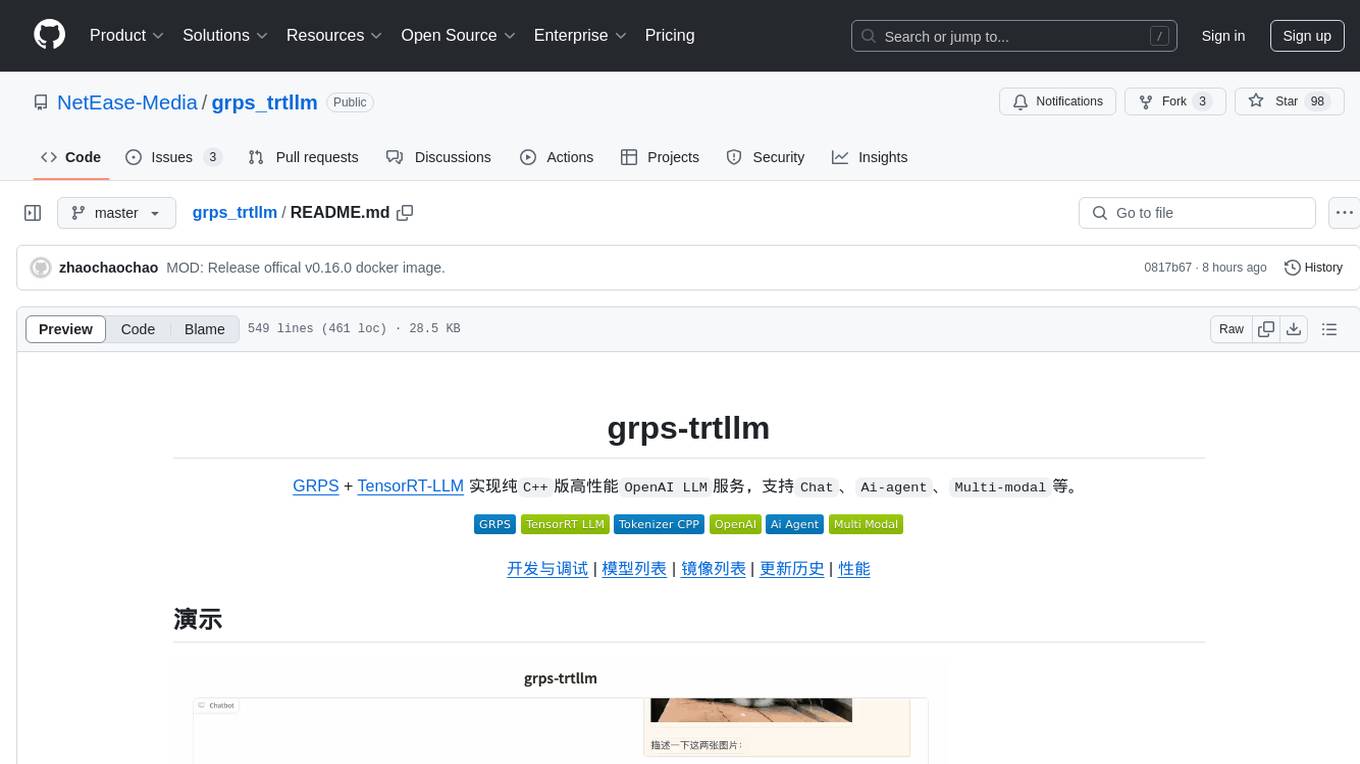
grps_trtllm
The grps-trtllm repository is a C++ implementation of a high-performance OpenAI LLM service, combining GRPS and TensorRT-LLM. It supports functionalities like Chat, Ai-agent, and Multi-modal. The repository offers advantages over triton-trtllm, including a complete LLM service implemented in pure C++, integrated tokenizer supporting huggingface and sentencepiece, custom HTTP functionality for OpenAI interface, support for different LLM prompt styles and result parsing styles, integration with tensorrt backend and opencv library for multi-modal LLM, and stable performance improvement compared to triton-trtllm.
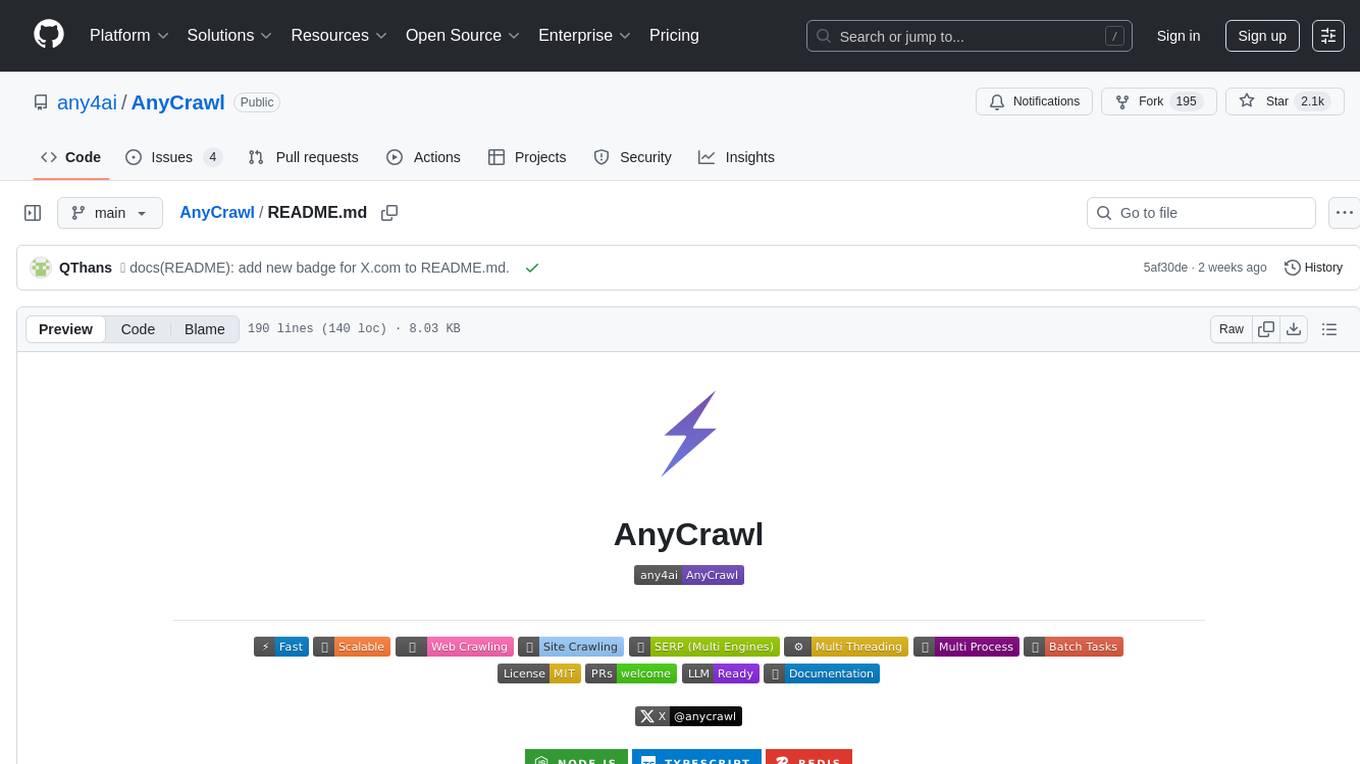
AnyCrawl
AnyCrawl is a high-performance crawling and scraping toolkit designed for SERP crawling, web scraping, site crawling, and batch tasks. It offers multi-threading and multi-process capabilities for high performance. The tool also provides AI extraction for structured data extraction from pages, making it LLM-friendly and easy to integrate and use.
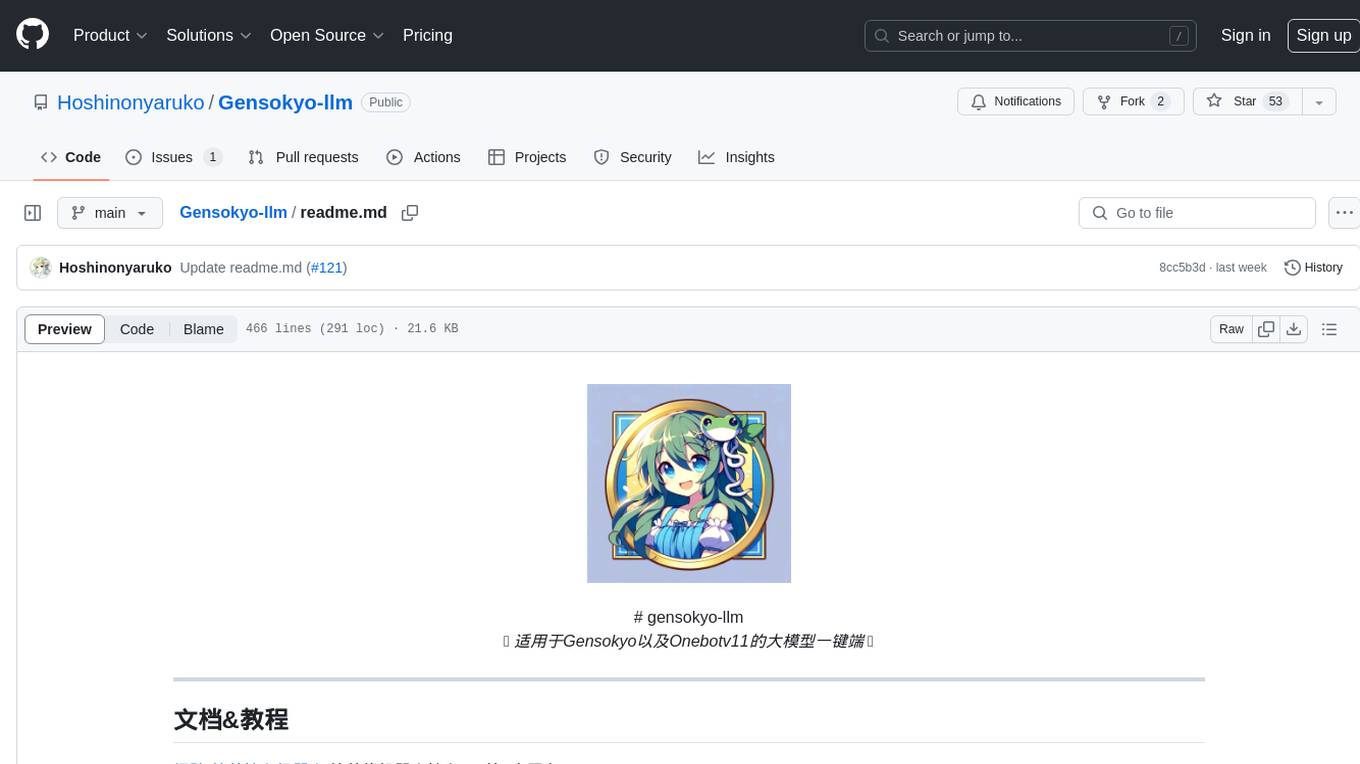
Gensokyo-llm
Gensokyo-llm is a tool designed for Gensokyo and Onebotv11, providing a one-click solution for large models. It supports various Onebotv11 standard frameworks, HTTP-API, and reverse WS. The tool is lightweight, with built-in SQLite for context maintenance and proxy support. It allows easy integration with the Gensokyo framework by configuring reverse HTTP and forward HTTP addresses. Users can set system settings, role cards, and context length. Additionally, it offers an openai original flavor API with automatic context. The tool can be used as an API or integrated with QQ channel robots. It supports converting GPT's SSE type and ensures memory safety in concurrent SSE environments. The tool also supports multiple users simultaneously transmitting SSE bidirectionally.
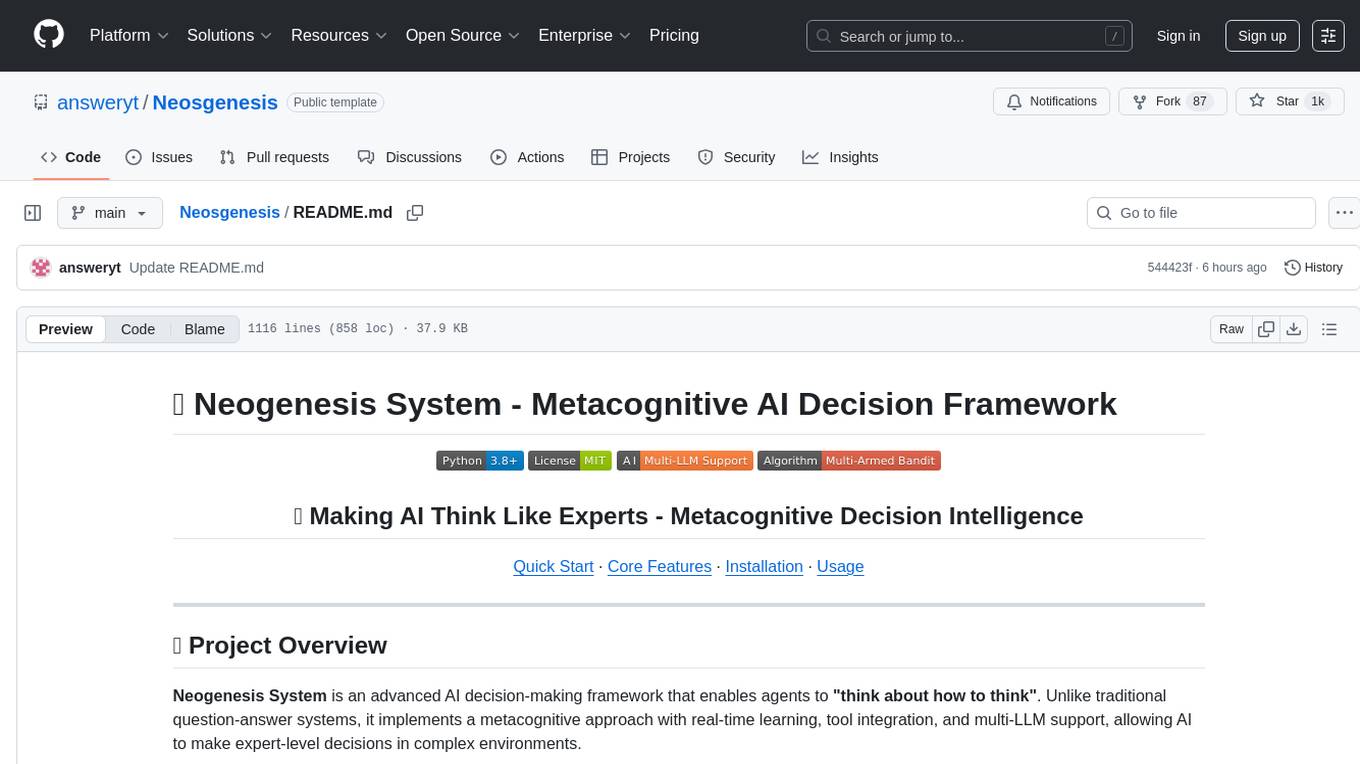
Neosgenesis
Neogenesis System is an advanced AI decision-making framework that enables agents to 'think about how to think'. It implements a metacognitive approach with real-time learning, tool integration, and multi-LLM support, allowing AI to make expert-level decisions in complex environments. Key features include metacognitive intelligence, tool-enhanced decisions, real-time learning, aha-moment breakthroughs, experience accumulation, and multi-LLM support.
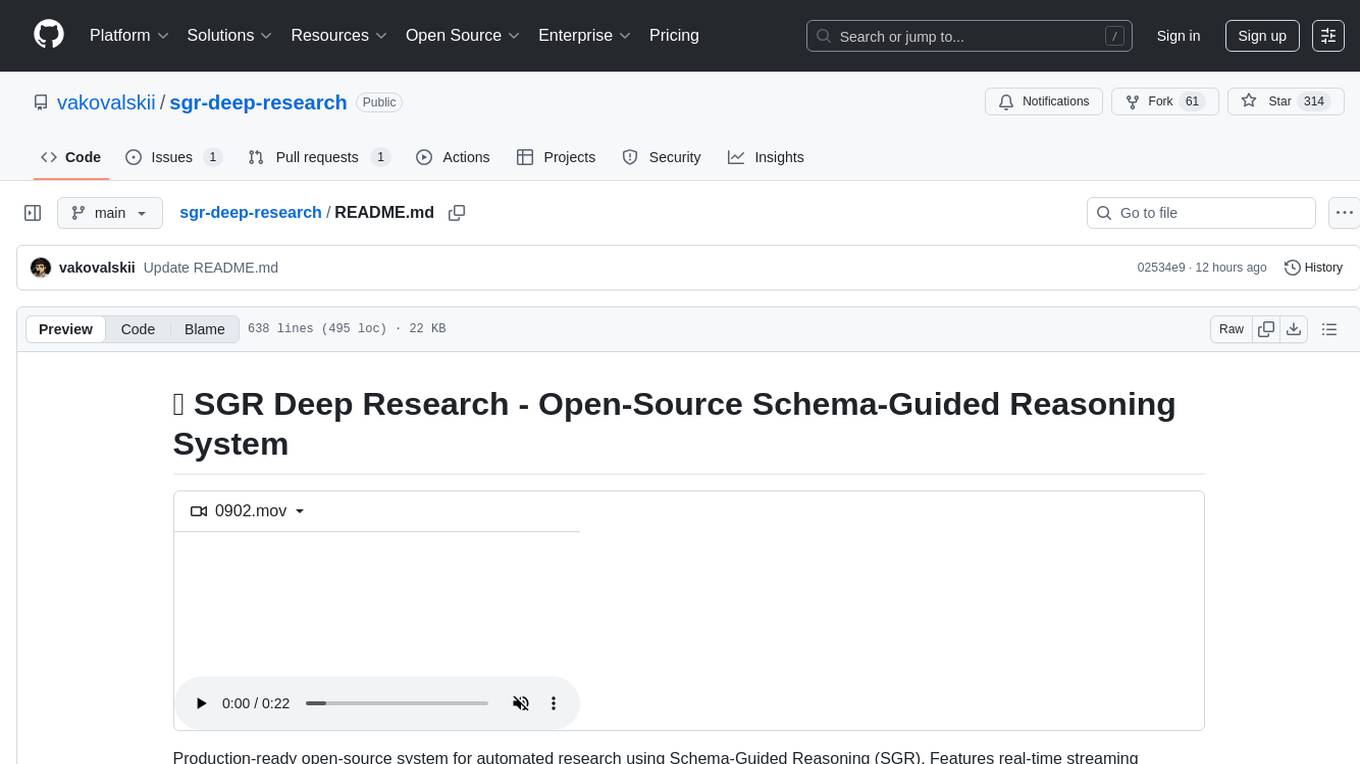
sgr-deep-research
This repository contains a deep learning research project focused on natural language processing tasks. It includes implementations of various state-of-the-art models and algorithms for text classification, sentiment analysis, named entity recognition, and more. The project aims to provide a comprehensive resource for researchers and developers interested in exploring deep learning techniques for NLP applications.
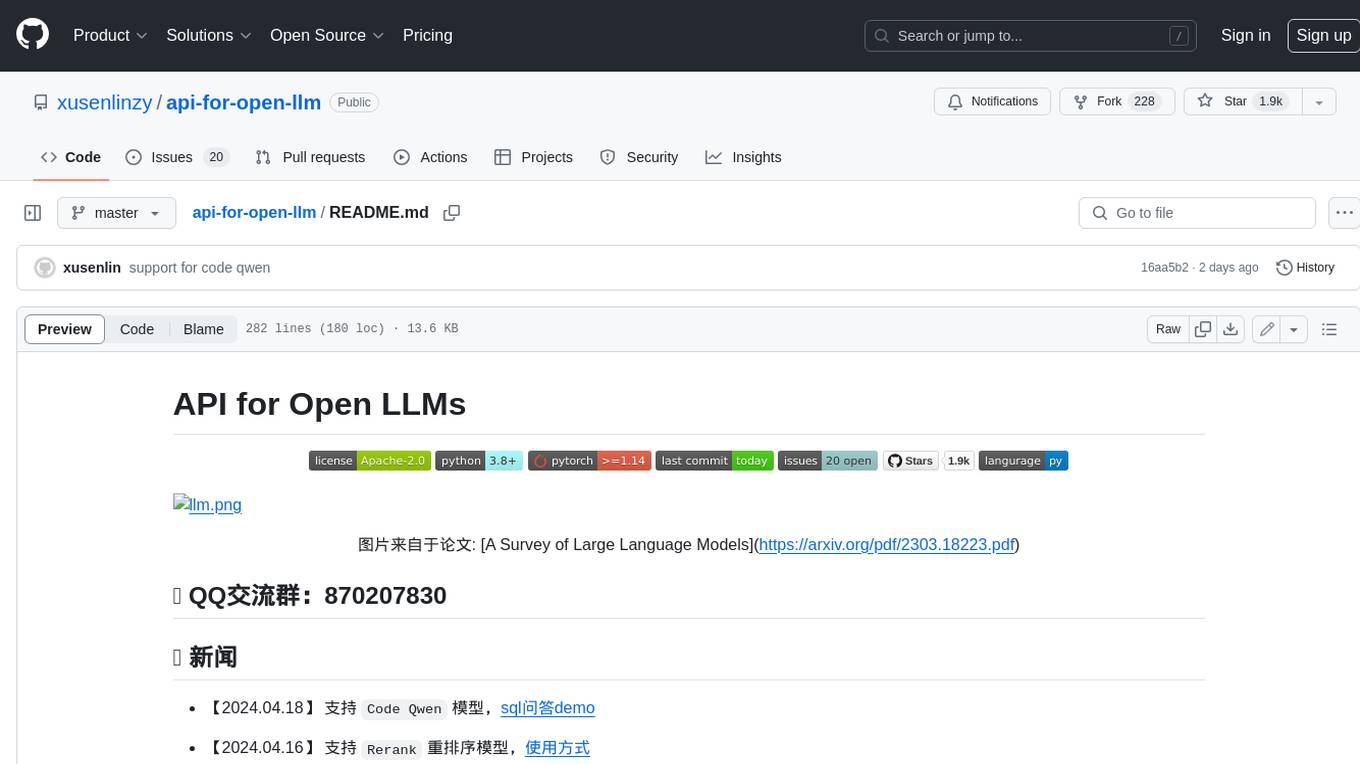
api-for-open-llm
This project provides a unified backend interface for open large language models (LLMs), offering a consistent experience with OpenAI's ChatGPT API. It supports various open-source LLMs, enabling developers to seamlessly integrate them into their applications. The interface features streaming responses, text embedding capabilities, and support for LangChain, a tool for developing LLM-based applications. By modifying environment variables, developers can easily use open-source models as alternatives to ChatGPT, providing a cost-effective and customizable solution for various use cases.
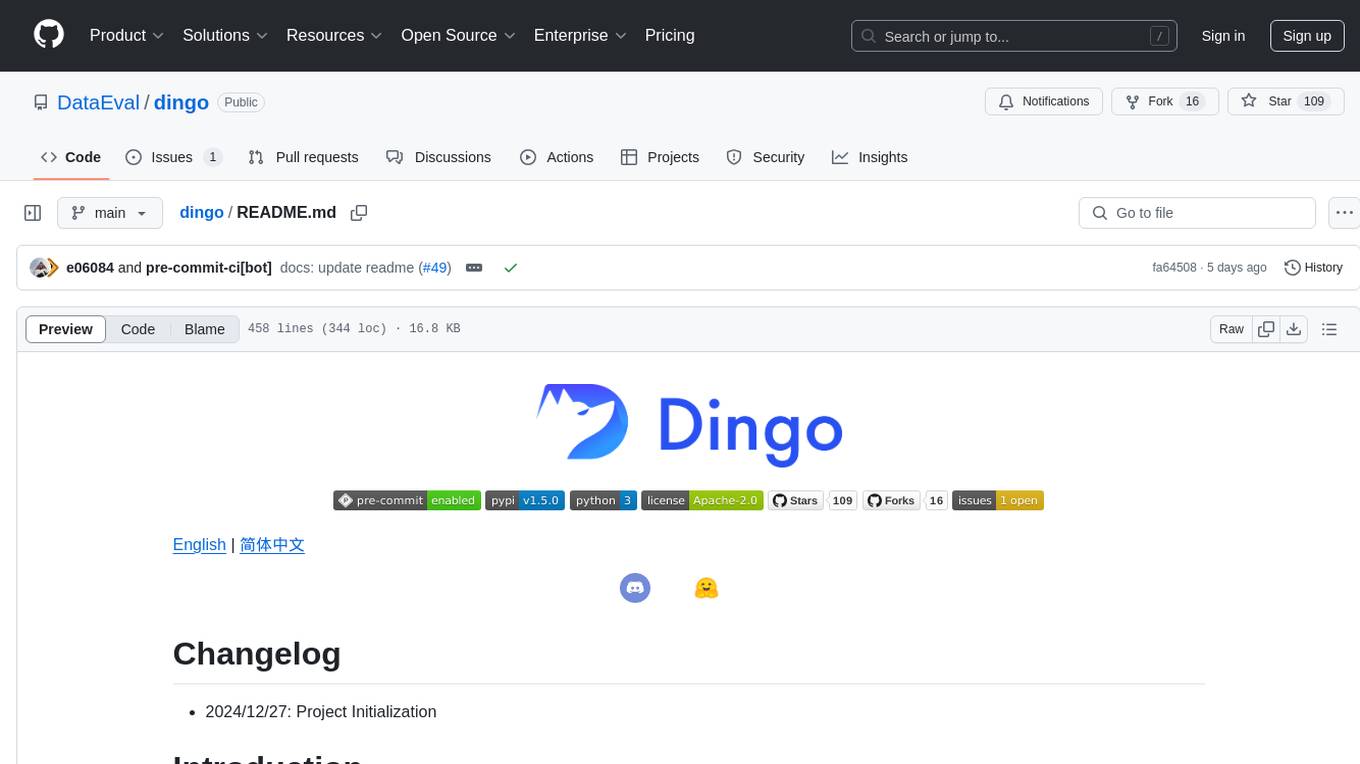
dingo
Dingo is a data quality evaluation tool that automatically detects data quality issues in datasets. It provides built-in rules and model evaluation methods, supports text and multimodal datasets, and offers local CLI and SDK usage. Dingo is designed for easy integration into evaluation platforms like OpenCompass.
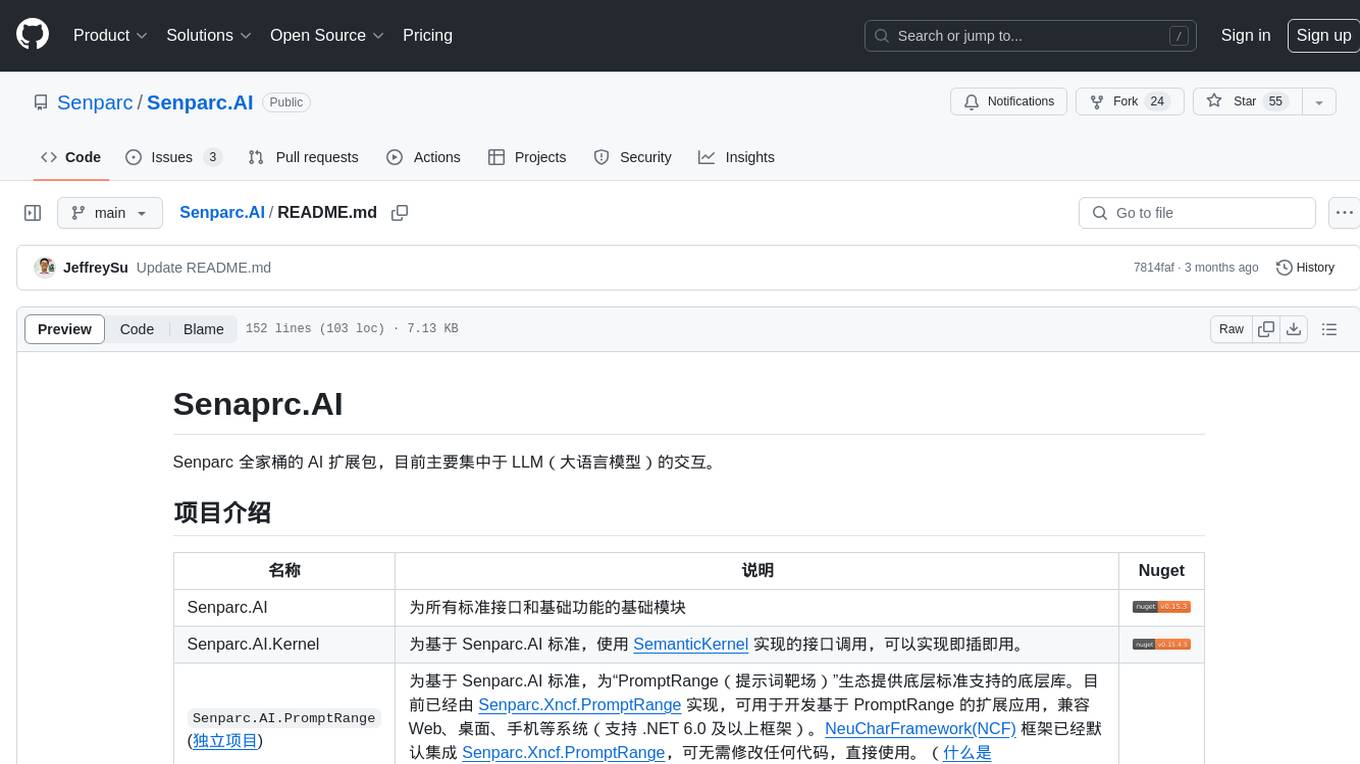
Senparc.AI
Senparc.AI is an AI extension package for the Senparc ecosystem, focusing on LLM (Large Language Models) interaction. It provides modules for standard interfaces and basic functionalities, as well as interfaces using SemanticKernel for plug-and-play capabilities. The package also includes a library for supporting the 'PromptRange' ecosystem, compatible with various systems and frameworks. Users can configure different AI platforms and models, define AI interface parameters, and run AI functions easily. The package offers examples and commands for dialogue, embedding, and DallE drawing operations.
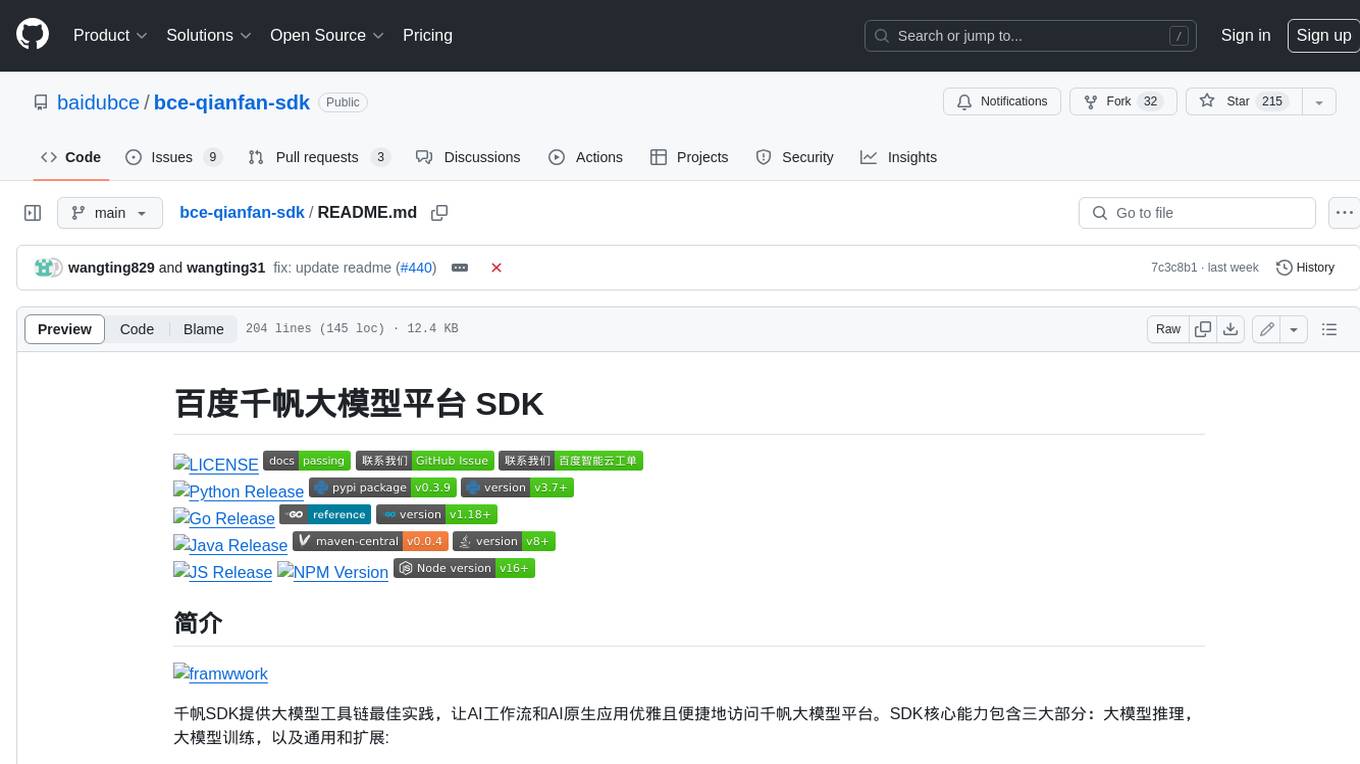
bce-qianfan-sdk
The Qianfan SDK provides best practices for large model toolchains, allowing AI workflows and AI-native applications to access the Qianfan large model platform elegantly and conveniently. The core capabilities of the SDK include three parts: large model reasoning, large model training, and general and extension: * `Large model reasoning`: Implements interface encapsulation for reasoning of Yuyan (ERNIE-Bot) series, open source large models, etc., supporting dialogue, completion, Embedding, etc. * `Large model training`: Based on platform capabilities, it supports end-to-end large model training process, including training data, fine-tuning/pre-training, and model services. * `General and extension`: General capabilities include common AI development tools such as Prompt/Debug/Client. The extension capability is based on the characteristics of Qianfan to adapt to common middleware frameworks.
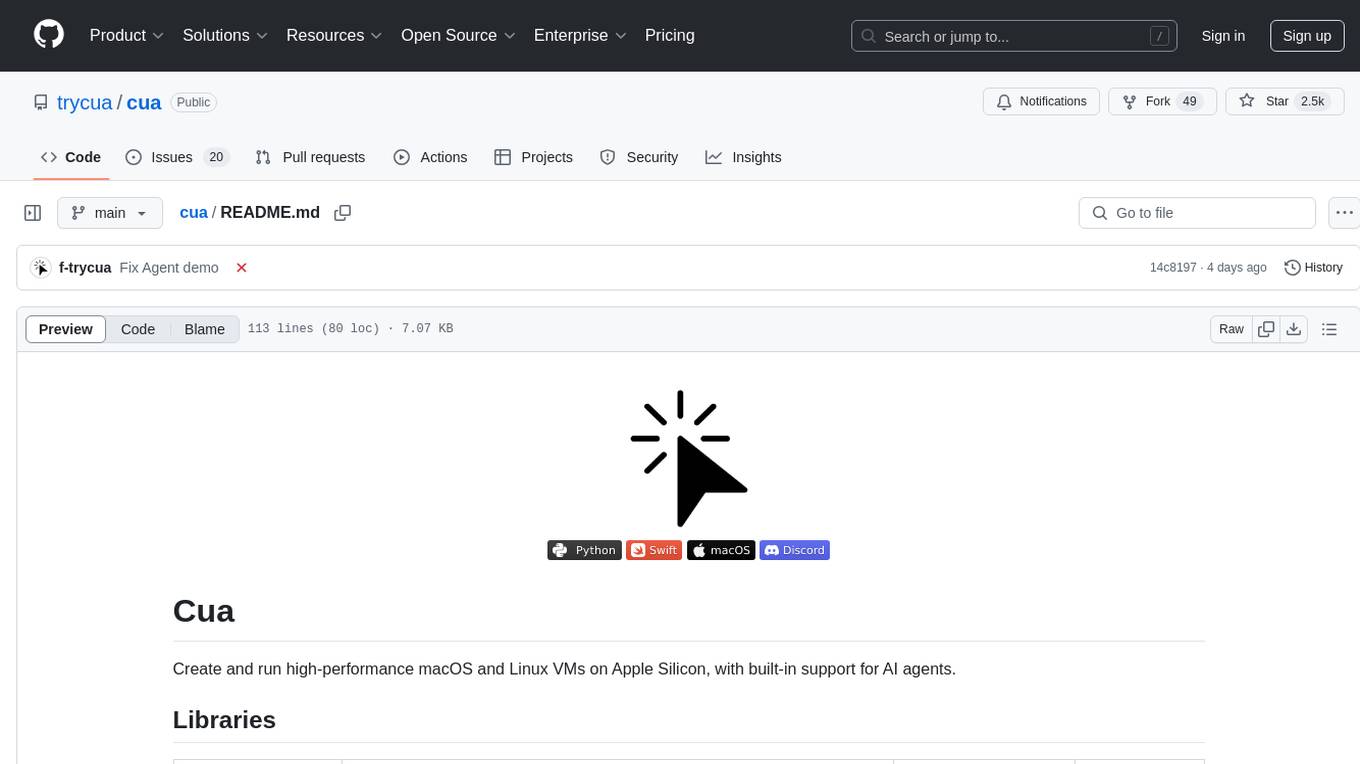
cua
Cua is a tool for creating and running high-performance macOS and Linux virtual machines on Apple Silicon, with built-in support for AI agents. It provides libraries like Lume for running VMs with near-native performance, Computer for interacting with sandboxes, and Agent for running agentic workflows. Users can refer to the documentation for onboarding, explore demos showcasing AI-Gradio and GitHub issue fixing, and utilize accessory libraries like Core, PyLume, Computer Server, and SOM. Contributions are welcome, and the tool is open-sourced under the MIT License.
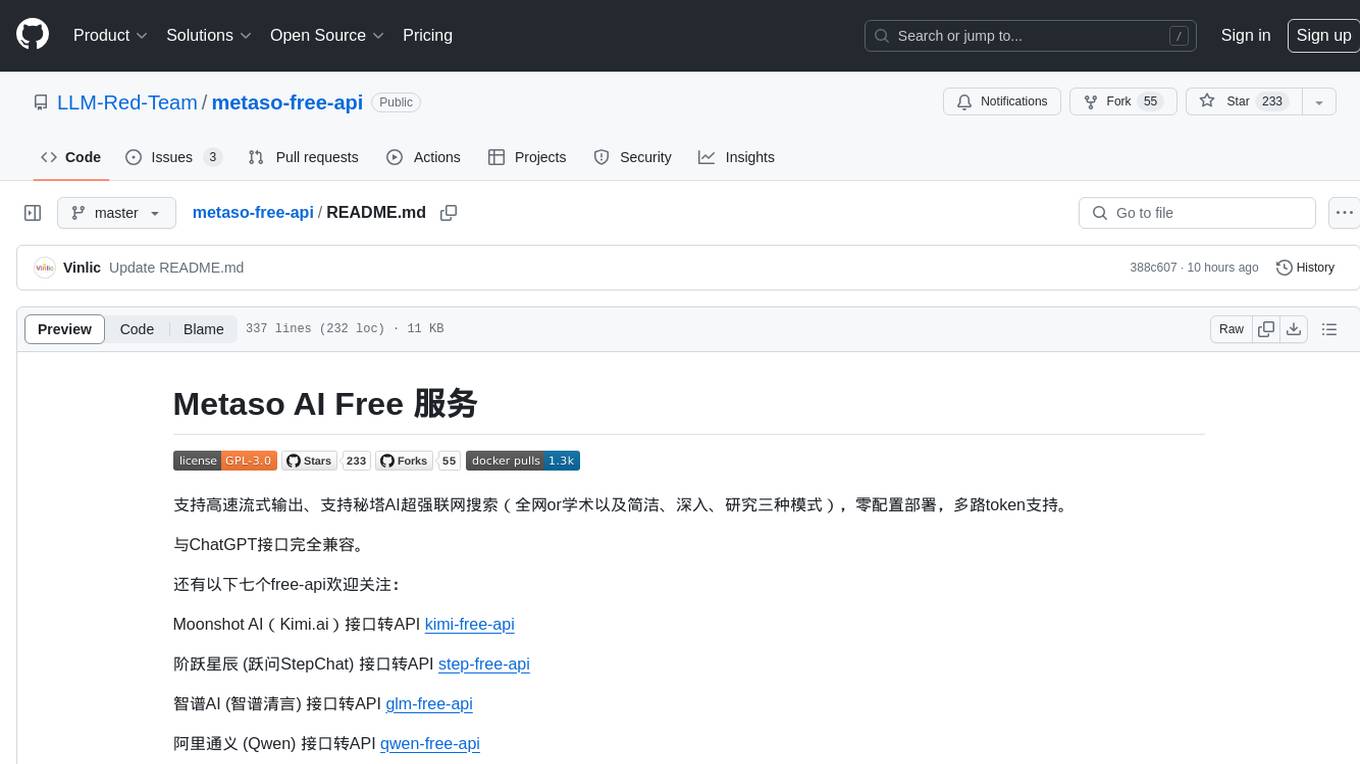
metaso-free-api
Metaso AI Free service supports high-speed streaming output, secret tower AI super network search (full network or academic as well as concise, in-depth, research three modes), zero-configuration deployment, multi-token support. Fully compatible with ChatGPT interface. It also has seven other free APIs available for use. The tool provides various deployment options such as Docker, Docker-compose, Render, Vercel, and native deployment. Users can access the tool for chat completions and token live checks. Note: Reverse API is unstable, it is recommended to use the official Metaso AI website to avoid the risk of banning. This project is for research and learning purposes only, not for commercial use.
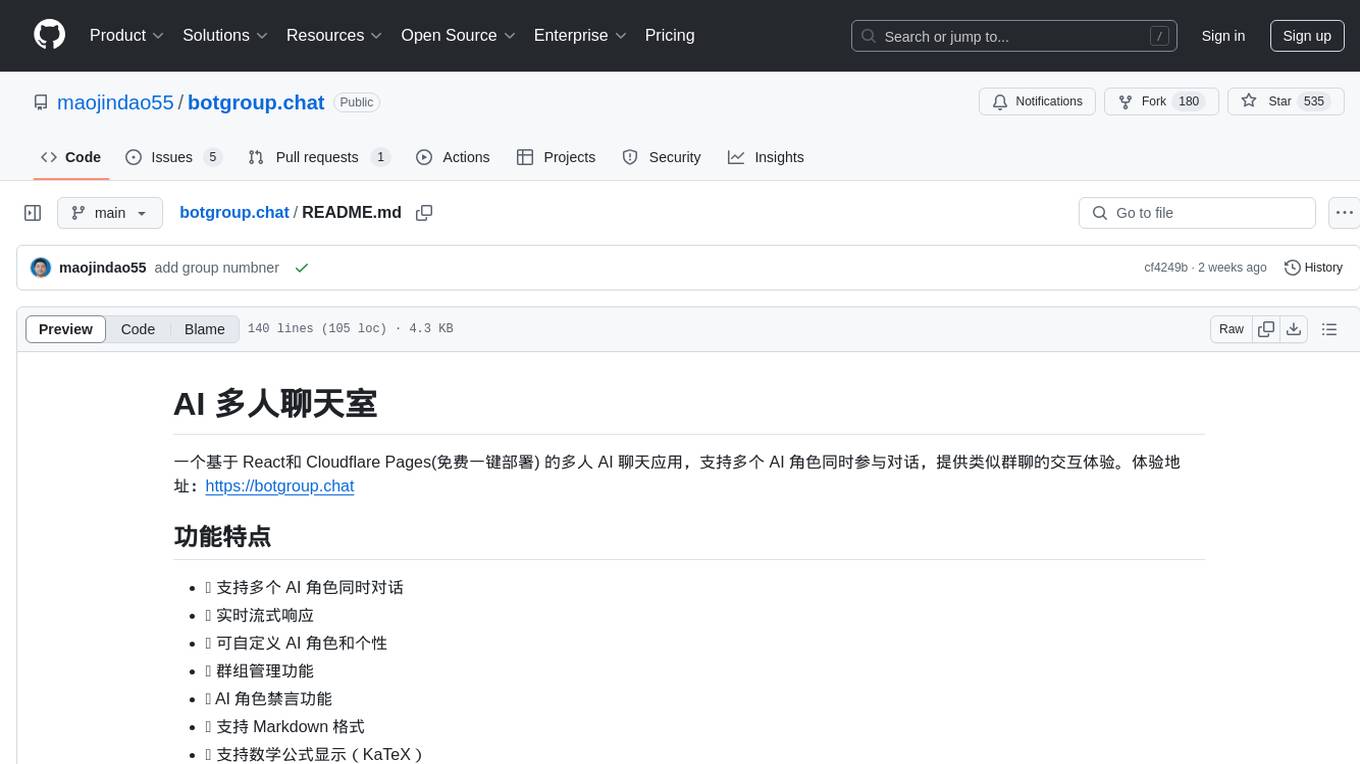
botgroup.chat
botgroup.chat is a multi-person AI chat application based on React and Cloudflare Pages for free one-click deployment. It supports multiple AI roles participating in conversations simultaneously, providing an interactive experience similar to group chat. The application features real-time streaming responses, customizable AI roles and personalities, group management functionality, AI role mute function, Markdown format support, mathematical formula display with KaTeX, aesthetically pleasing UI design, and responsive design for mobile devices.
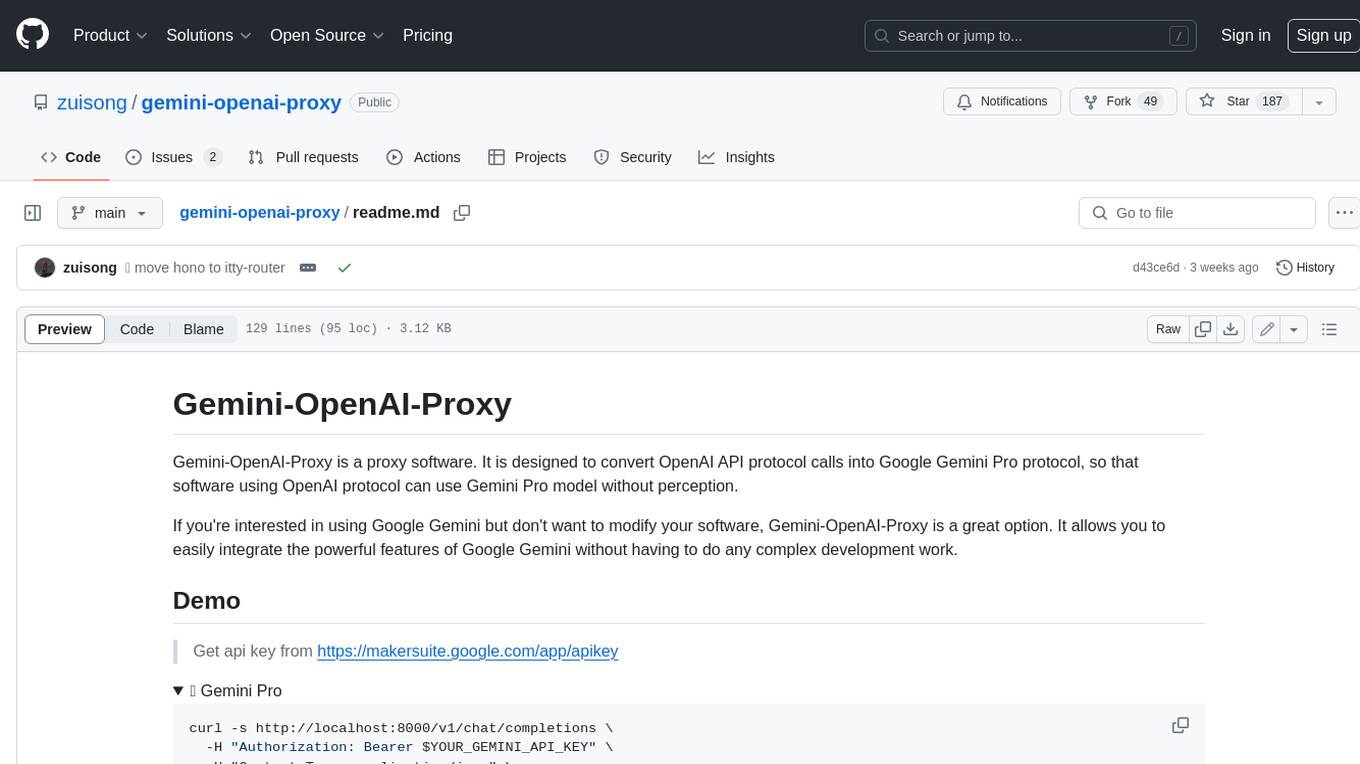
gemini-openai-proxy
Gemini-OpenAI-Proxy is a proxy software designed to convert OpenAI API protocol calls into Google Gemini Pro protocol, allowing software using OpenAI protocol to utilize Gemini Pro models seamlessly. It provides an easy integration of Gemini Pro's powerful features without the need for complex development work.
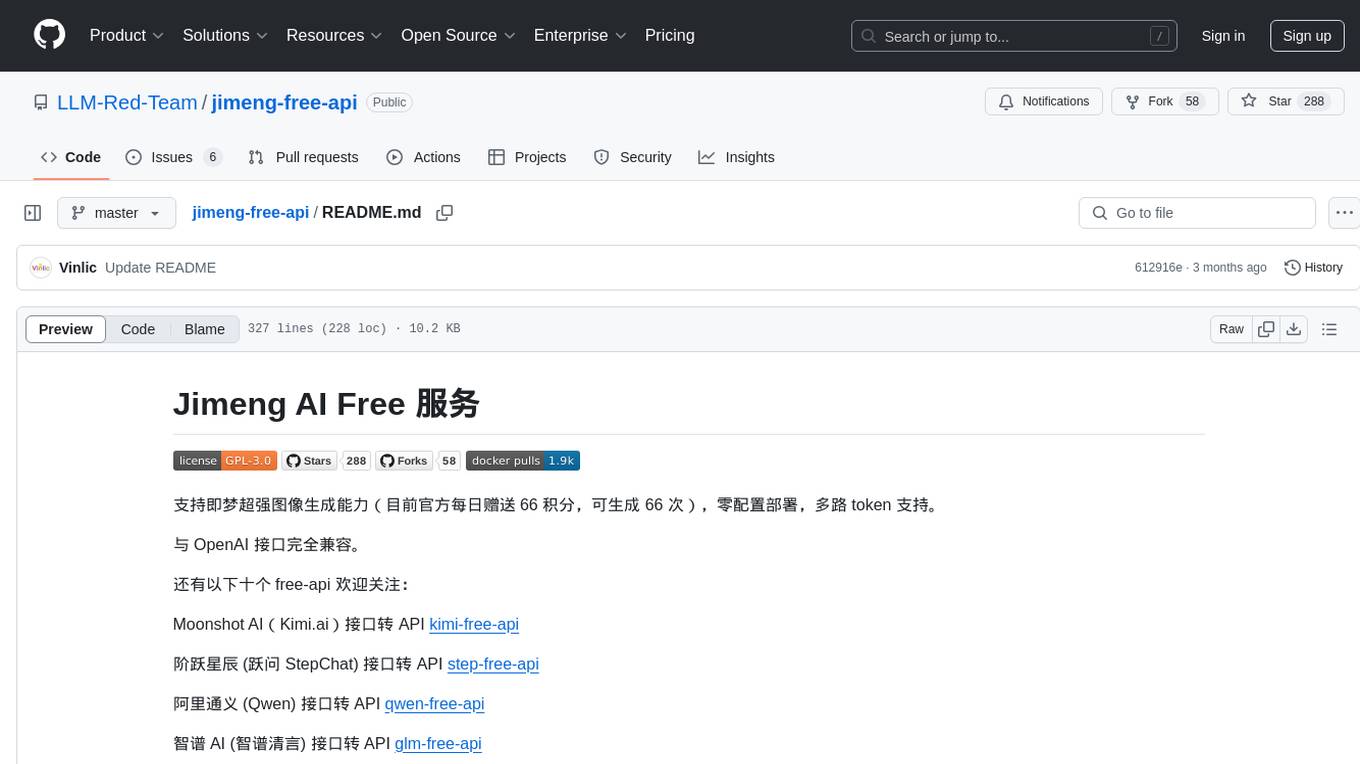
jimeng-free-api
Jimeng AI Free service provides powerful image generation capabilities with zero configuration deployment and support for multiple tokens. It is fully compatible with the OpenAI interface. The repository also includes other free APIs like Moonshot AI, StepChat, Qwen, GLM AI, Metaso AI, Doubao by ByteDance, Spark by Xunfei, Hailuo AI, DeepSeek, and Emohaa AI. Users can access the service by obtaining a sessionid from Jimeng and using it as a Bearer Token in the Authorization header for API requests. The service supports chat completions and image generations, with different models and parameters available for customization. Various deployment options are provided, including Docker, Docker-compose, Render, Vercel, and native deployment. Users are advised to use the recommended client applications for faster and simpler access to the free API services.
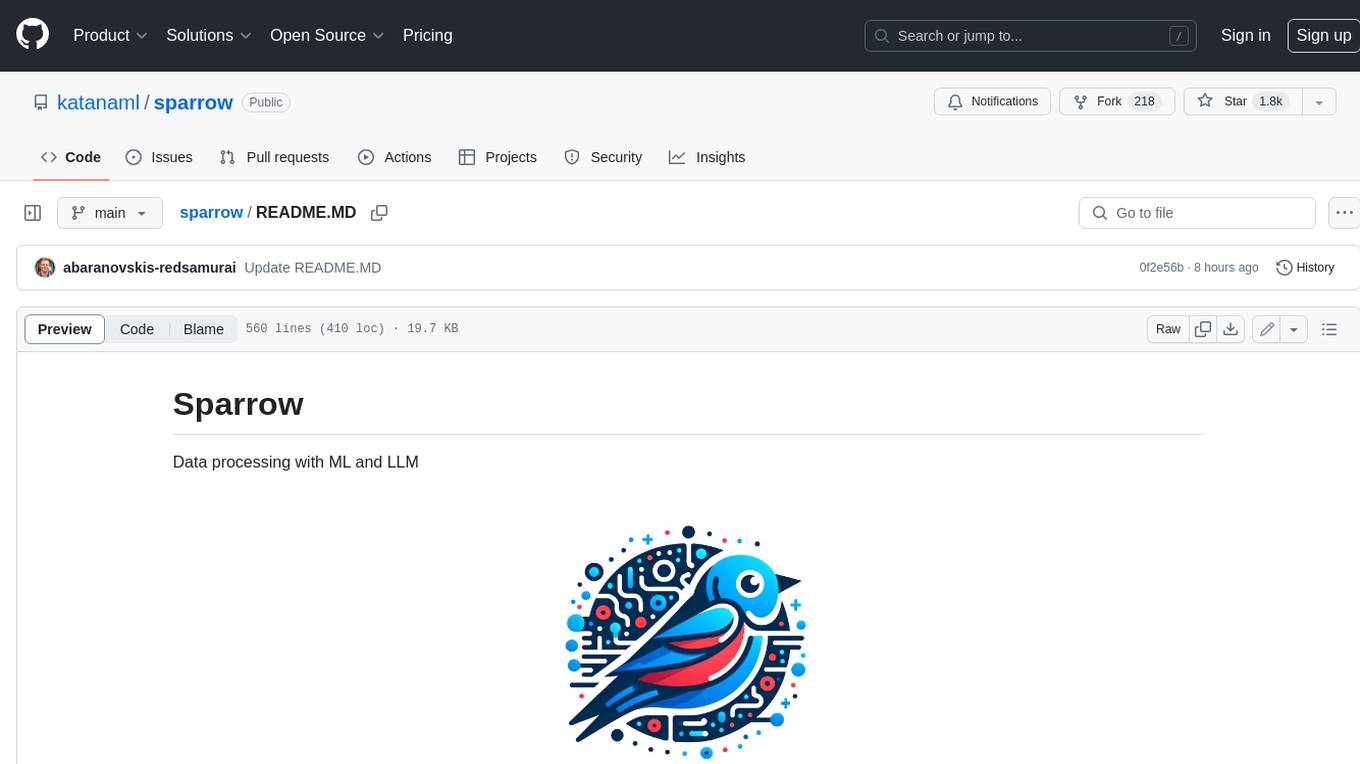
sparrow
Sparrow is an innovative open-source solution for efficient data extraction and processing from various documents and images. It seamlessly handles forms, invoices, receipts, and other unstructured data sources. Sparrow stands out with its modular architecture, offering independent services and pipelines all optimized for robust performance. One of the critical functionalities of Sparrow - pluggable architecture. You can easily integrate and run data extraction pipelines using tools and frameworks like LlamaIndex, Haystack, or Unstructured. Sparrow enables local LLM data extraction pipelines through Ollama or Apple MLX. With Sparrow solution you get API, which helps to process and transform your data into structured output, ready to be integrated with custom workflows. Sparrow Agents - with Sparrow you can build independent LLM agents, and use API to invoke them from your system. **List of available agents:** * **llamaindex** - RAG pipeline with LlamaIndex for PDF processing * **vllamaindex** - RAG pipeline with LLamaIndex multimodal for image processing * **vprocessor** - RAG pipeline with OCR and LlamaIndex for image processing * **haystack** - RAG pipeline with Haystack for PDF processing * **fcall** - Function call pipeline * **unstructured-light** - RAG pipeline with Unstructured and LangChain, supports PDF and image processing * **unstructured** - RAG pipeline with Weaviate vector DB query, Unstructured and LangChain, supports PDF and image processing * **instructor** - RAG pipeline with Unstructured and Instructor libraries, supports PDF and image processing. Works great for JSON response generation
For similar tasks
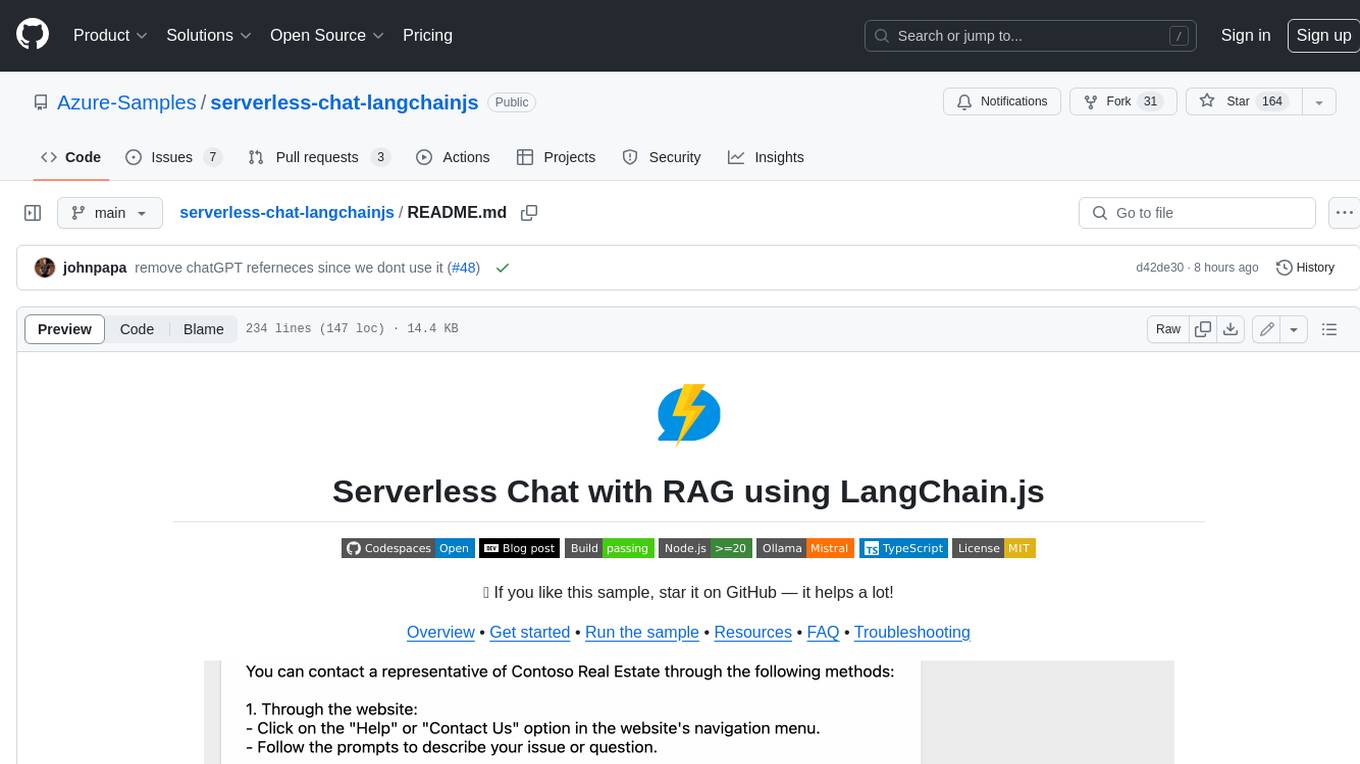
serverless-chat-langchainjs
This sample shows how to build a serverless chat experience with Retrieval-Augmented Generation using LangChain.js and Azure. The application is hosted on Azure Static Web Apps and Azure Functions, with Azure Cosmos DB for MongoDB vCore as the vector database. You can use it as a starting point for building more complex AI applications.
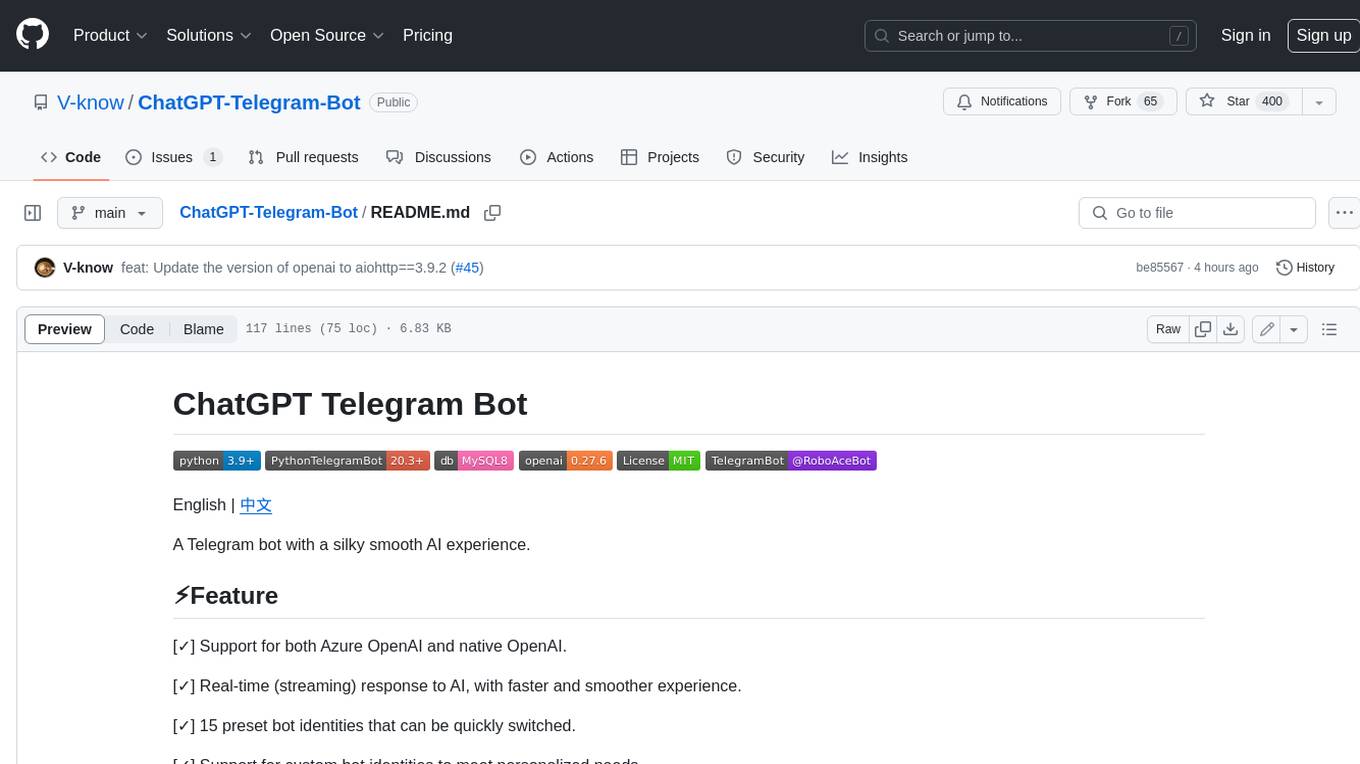
ChatGPT-Telegram-Bot
ChatGPT Telegram Bot is a Telegram bot that provides a smooth AI experience. It supports both Azure OpenAI and native OpenAI, and offers real-time (streaming) response to AI, with a faster and smoother experience. The bot also has 15 preset bot identities that can be quickly switched, and supports custom bot identities to meet personalized needs. Additionally, it supports clearing the contents of the chat with a single click, and restarting the conversation at any time. The bot also supports native Telegram bot button support, making it easy and intuitive to implement required functions. User level division is also supported, with different levels enjoying different single session token numbers, context numbers, and session frequencies. The bot supports English and Chinese on UI, and is containerized for easy deployment.
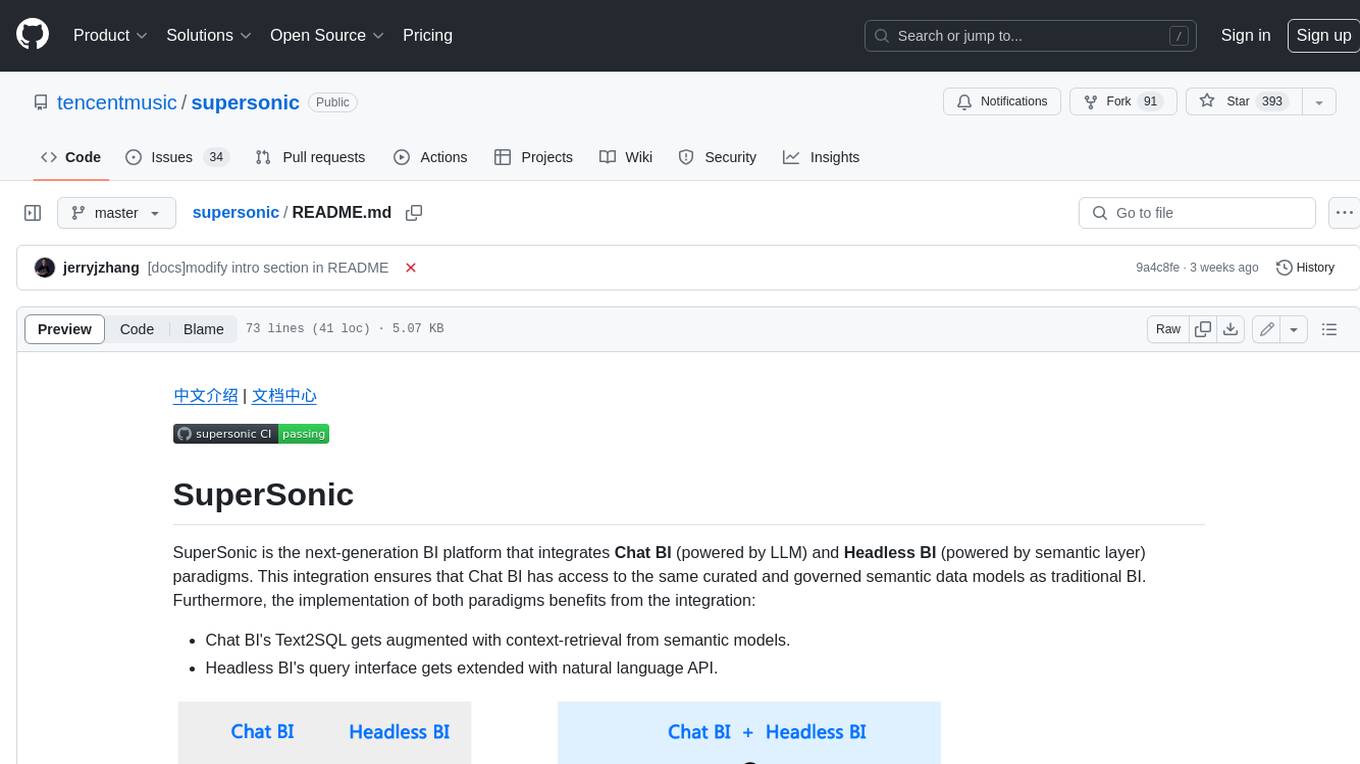
supersonic
SuperSonic is a next-generation BI platform that integrates Chat BI (powered by LLM) and Headless BI (powered by semantic layer) paradigms. This integration ensures that Chat BI has access to the same curated and governed semantic data models as traditional BI. Furthermore, the implementation of both paradigms benefits from the integration: * Chat BI's Text2SQL gets augmented with context-retrieval from semantic models. * Headless BI's query interface gets extended with natural language API. SuperSonic provides a Chat BI interface that empowers users to query data using natural language and visualize the results with suitable charts. To enable such experience, the only thing necessary is to build logical semantic models (definition of metric/dimension/tag, along with their meaning and relationships) through a Headless BI interface. Meanwhile, SuperSonic is designed to be extensible and composable, allowing custom implementations to be added and configured with Java SPI. The integration of Chat BI and Headless BI has the potential to enhance the Text2SQL generation in two dimensions: 1. Incorporate data semantics (such as business terms, column values, etc.) into the prompt, enabling LLM to better understand the semantics and reduce hallucination. 2. Offload the generation of advanced SQL syntax (such as join, formula, etc.) from LLM to the semantic layer to reduce complexity. With these ideas in mind, we develop SuperSonic as a practical reference implementation and use it to power our real-world products. Additionally, to facilitate further development we decide to open source SuperSonic as an extensible framework.
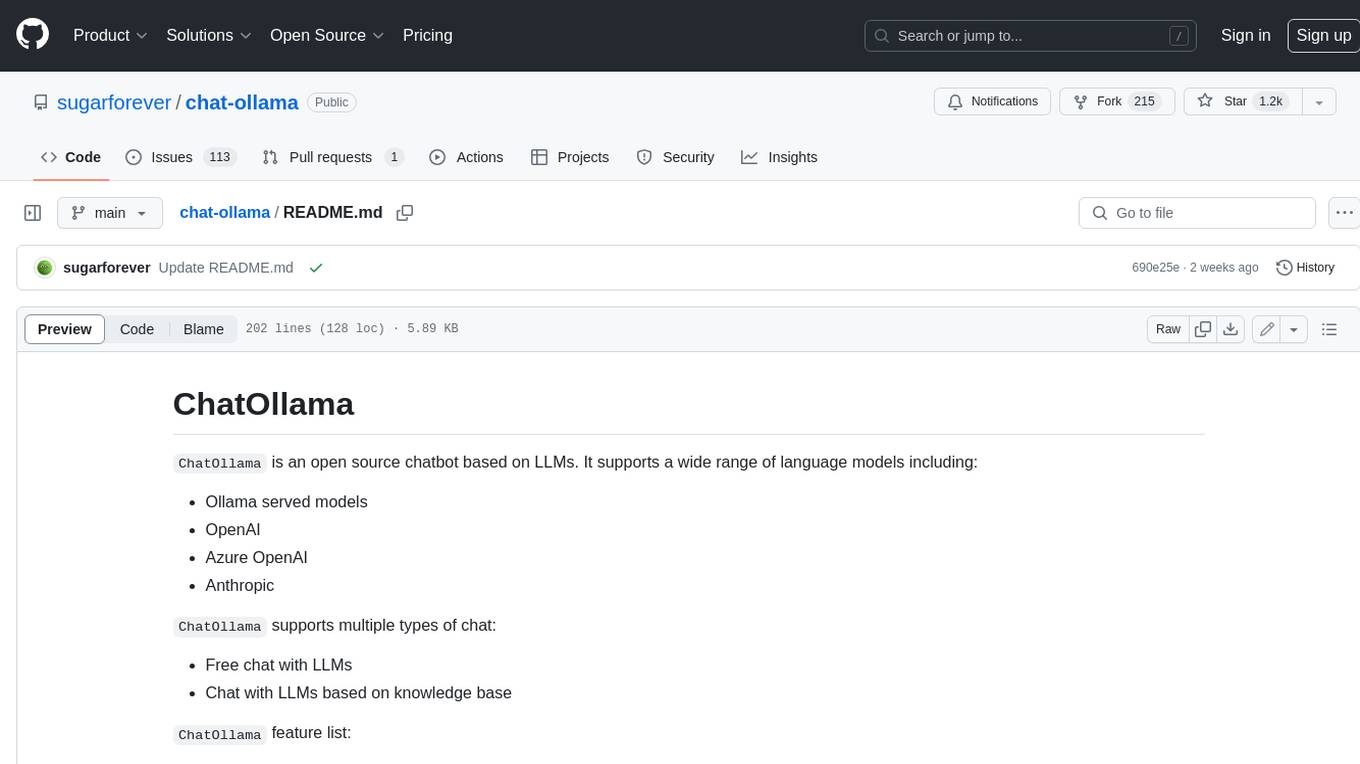
chat-ollama
ChatOllama is an open-source chatbot based on LLMs (Large Language Models). It supports a wide range of language models, including Ollama served models, OpenAI, Azure OpenAI, and Anthropic. ChatOllama supports multiple types of chat, including free chat with LLMs and chat with LLMs based on a knowledge base. Key features of ChatOllama include Ollama models management, knowledge bases management, chat, and commercial LLMs API keys management.
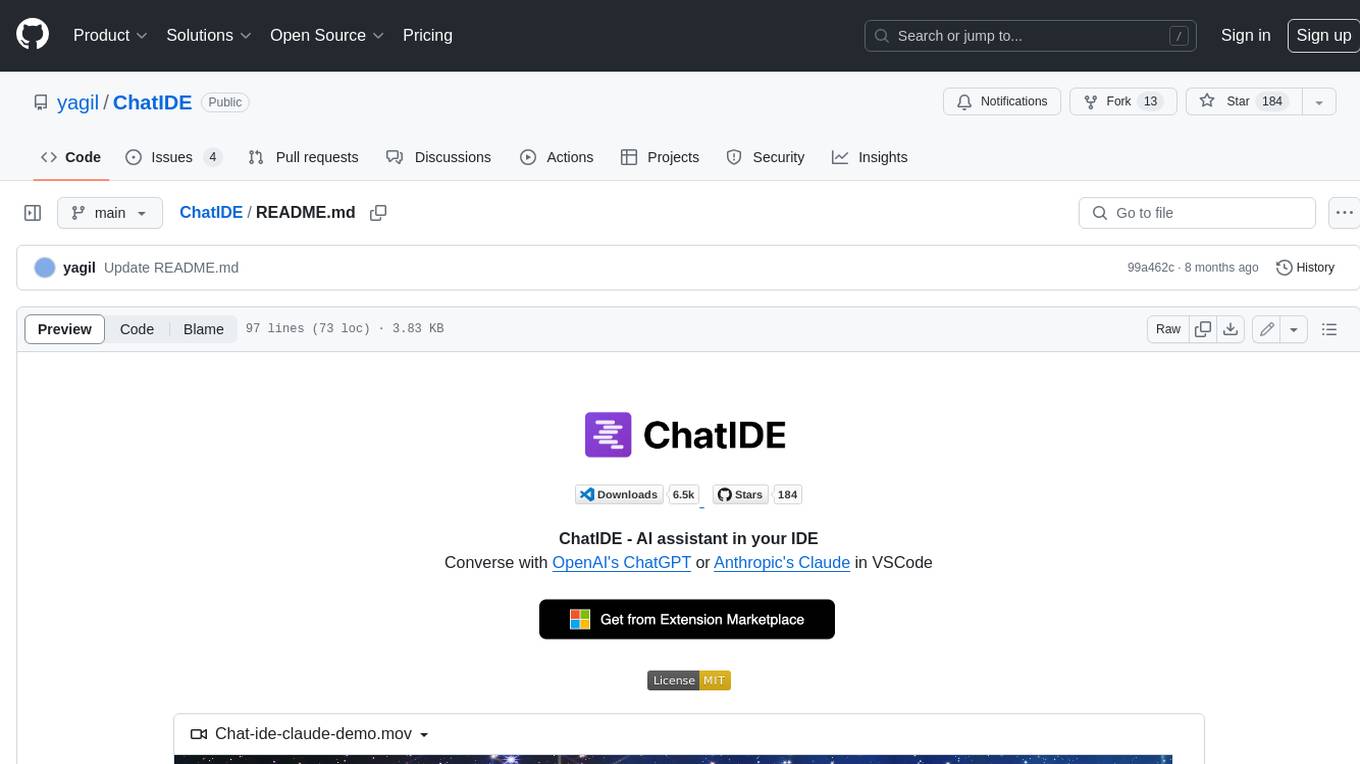
ChatIDE
ChatIDE is an AI assistant that integrates with your IDE, allowing you to converse with OpenAI's ChatGPT or Anthropic's Claude within your development environment. It provides a seamless way to access AI-powered assistance while coding, enabling you to get real-time help, generate code snippets, debug errors, and brainstorm ideas without leaving your IDE.
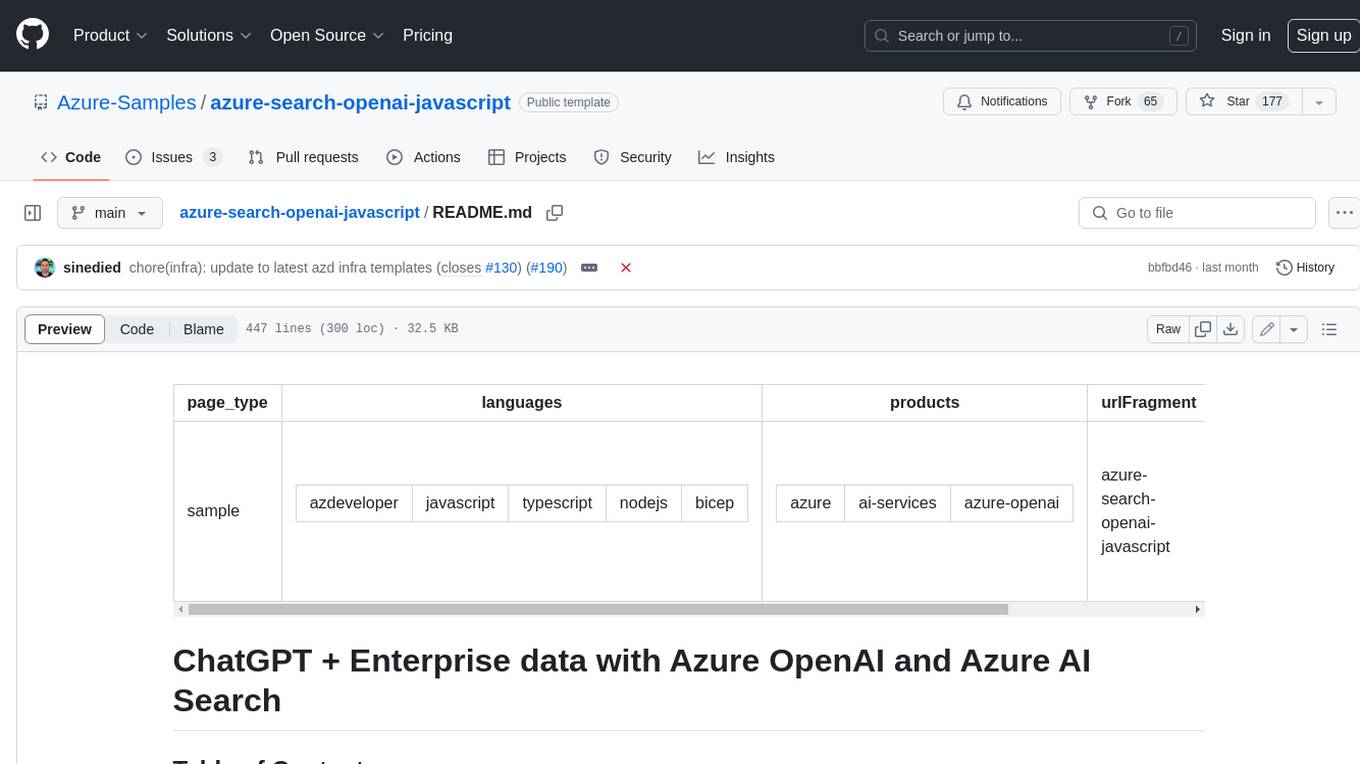
azure-search-openai-javascript
This sample demonstrates a few approaches for creating ChatGPT-like experiences over your own data using the Retrieval Augmented Generation pattern. It uses Azure OpenAI Service to access the ChatGPT model (gpt-35-turbo), and Azure AI Search for data indexing and retrieval.
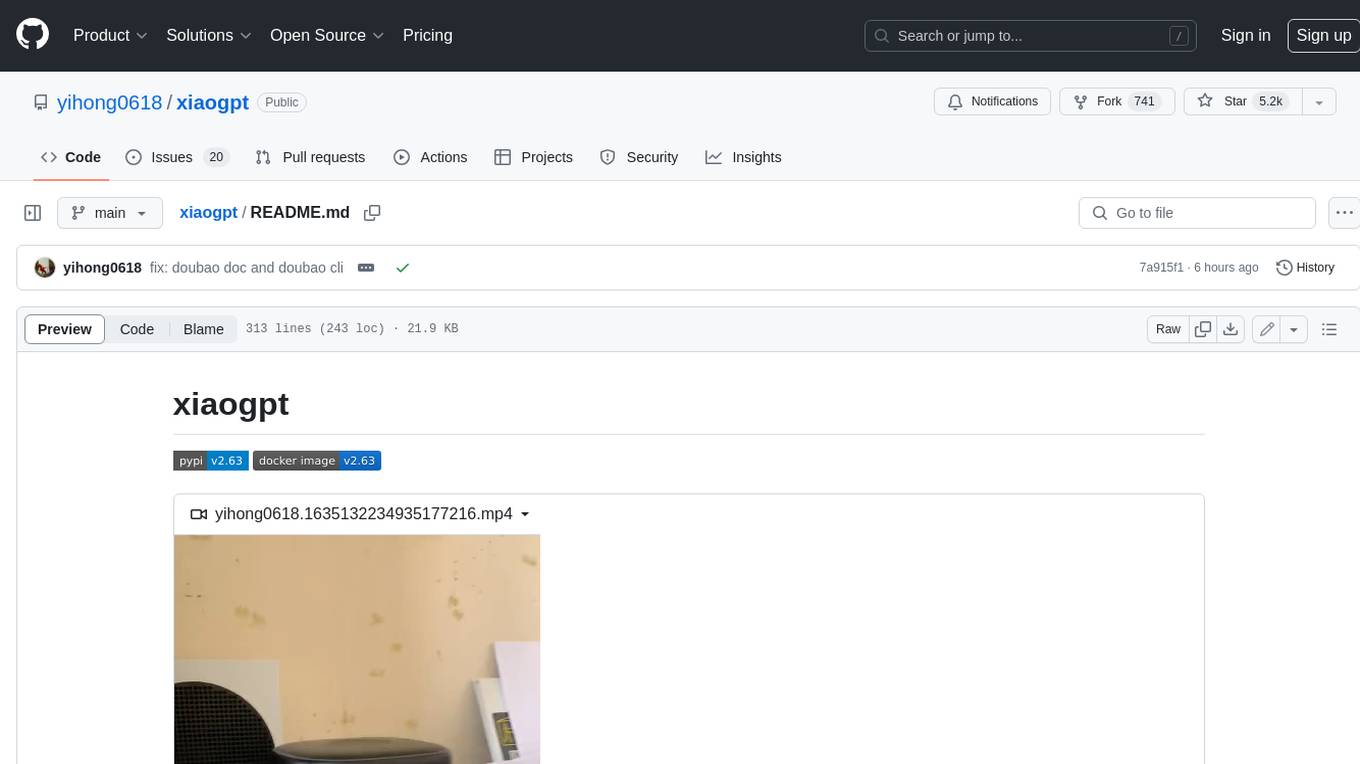
xiaogpt
xiaogpt is a tool that allows you to play ChatGPT and other LLMs with Xiaomi AI Speaker. It supports ChatGPT, New Bing, ChatGLM, Gemini, Doubao, and Tongyi Qianwen. You can use it to ask questions, get answers, and have conversations with AI assistants. xiaogpt is easy to use and can be set up in a few minutes. It is a great way to experience the power of AI and have fun with your Xiaomi AI Speaker.
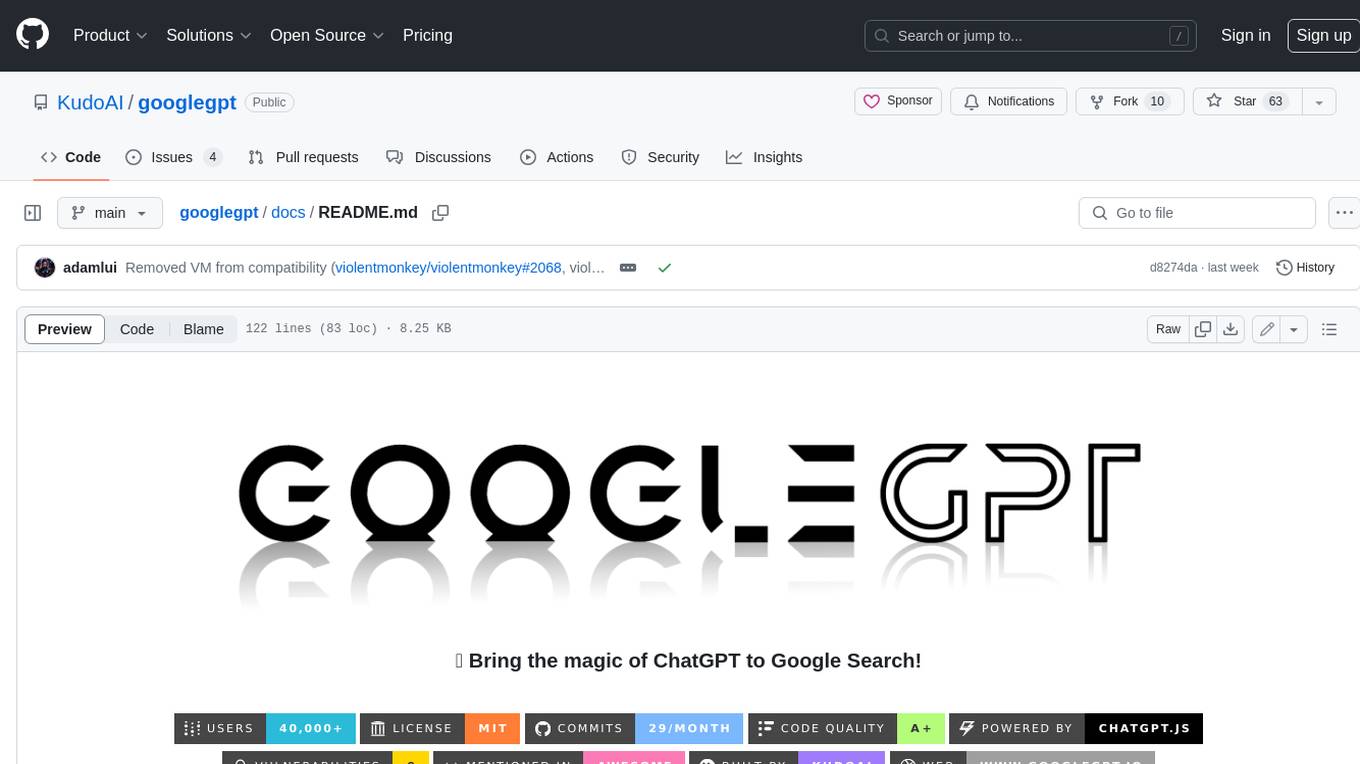
googlegpt
GoogleGPT is a browser extension that brings the power of ChatGPT to Google Search. With GoogleGPT, you can ask ChatGPT questions and get answers directly in your search results. You can also use GoogleGPT to generate text, translate languages, and more. GoogleGPT is compatible with all major browsers, including Chrome, Firefox, Edge, and Safari.
For similar jobs
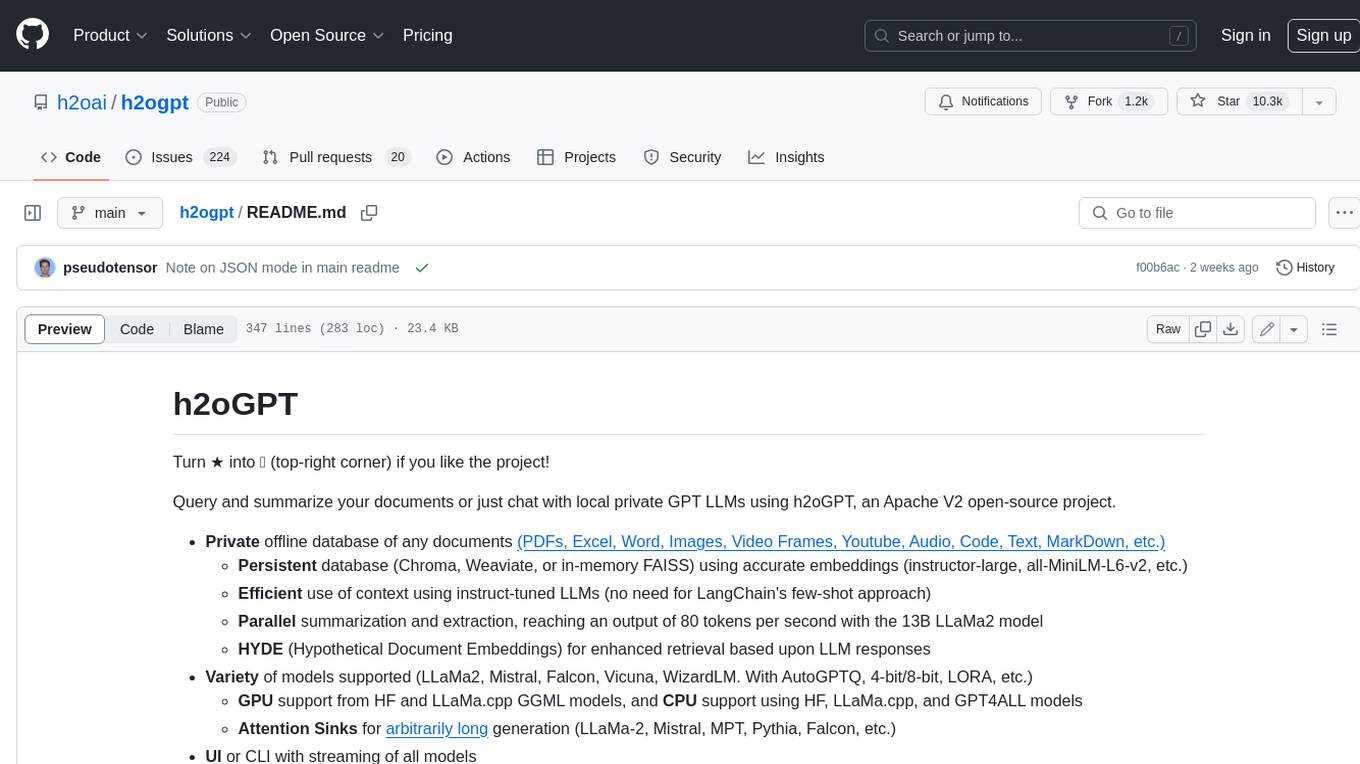
h2ogpt
h2oGPT is an Apache V2 open-source project that allows users to query and summarize documents or chat with local private GPT LLMs. It features a private offline database of any documents (PDFs, Excel, Word, Images, Video Frames, Youtube, Audio, Code, Text, MarkDown, etc.), a persistent database (Chroma, Weaviate, or in-memory FAISS) using accurate embeddings (instructor-large, all-MiniLM-L6-v2, etc.), and efficient use of context using instruct-tuned LLMs (no need for LangChain's few-shot approach). h2oGPT also offers parallel summarization and extraction, reaching an output of 80 tokens per second with the 13B LLaMa2 model, HYDE (Hypothetical Document Embeddings) for enhanced retrieval based upon LLM responses, a variety of models supported (LLaMa2, Mistral, Falcon, Vicuna, WizardLM. With AutoGPTQ, 4-bit/8-bit, LORA, etc.), GPU support from HF and LLaMa.cpp GGML models, and CPU support using HF, LLaMa.cpp, and GPT4ALL models. Additionally, h2oGPT provides Attention Sinks for arbitrarily long generation (LLaMa-2, Mistral, MPT, Pythia, Falcon, etc.), a UI or CLI with streaming of all models, the ability to upload and view documents through the UI (control multiple collaborative or personal collections), Vision Models LLaVa, Claude-3, Gemini-Pro-Vision, GPT-4-Vision, Image Generation Stable Diffusion (sdxl-turbo, sdxl) and PlaygroundAI (playv2), Voice STT using Whisper with streaming audio conversion, Voice TTS using MIT-Licensed Microsoft Speech T5 with multiple voices and Streaming audio conversion, Voice TTS using MPL2-Licensed TTS including Voice Cloning and Streaming audio conversion, AI Assistant Voice Control Mode for hands-free control of h2oGPT chat, Bake-off UI mode against many models at the same time, Easy Download of model artifacts and control over models like LLaMa.cpp through the UI, Authentication in the UI by user/password via Native or Google OAuth, State Preservation in the UI by user/password, Linux, Docker, macOS, and Windows support, Easy Windows Installer for Windows 10 64-bit (CPU/CUDA), Easy macOS Installer for macOS (CPU/M1/M2), Inference Servers support (oLLaMa, HF TGI server, vLLM, Gradio, ExLLaMa, Replicate, OpenAI, Azure OpenAI, Anthropic), OpenAI-compliant, Server Proxy API (h2oGPT acts as drop-in-replacement to OpenAI server), Python client API (to talk to Gradio server), JSON Mode with any model via code block extraction. Also supports MistralAI JSON mode, Claude-3 via function calling with strict Schema, OpenAI via JSON mode, and vLLM via guided_json with strict Schema, Web-Search integration with Chat and Document Q/A, Agents for Search, Document Q/A, Python Code, CSV frames (Experimental, best with OpenAI currently), Evaluate performance using reward models, and Quality maintained with over 1000 unit and integration tests taking over 4 GPU-hours.
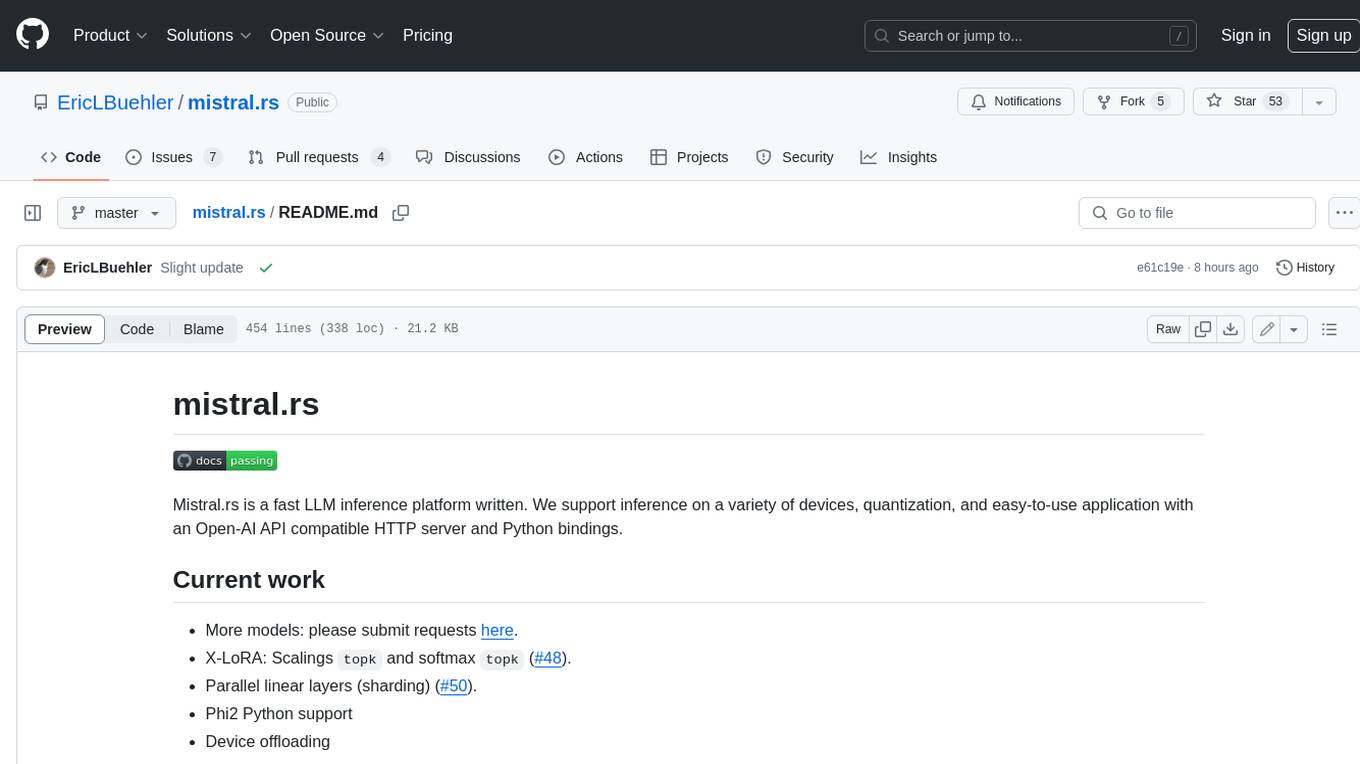
mistral.rs
Mistral.rs is a fast LLM inference platform written in Rust. We support inference on a variety of devices, quantization, and easy-to-use application with an Open-AI API compatible HTTP server and Python bindings.
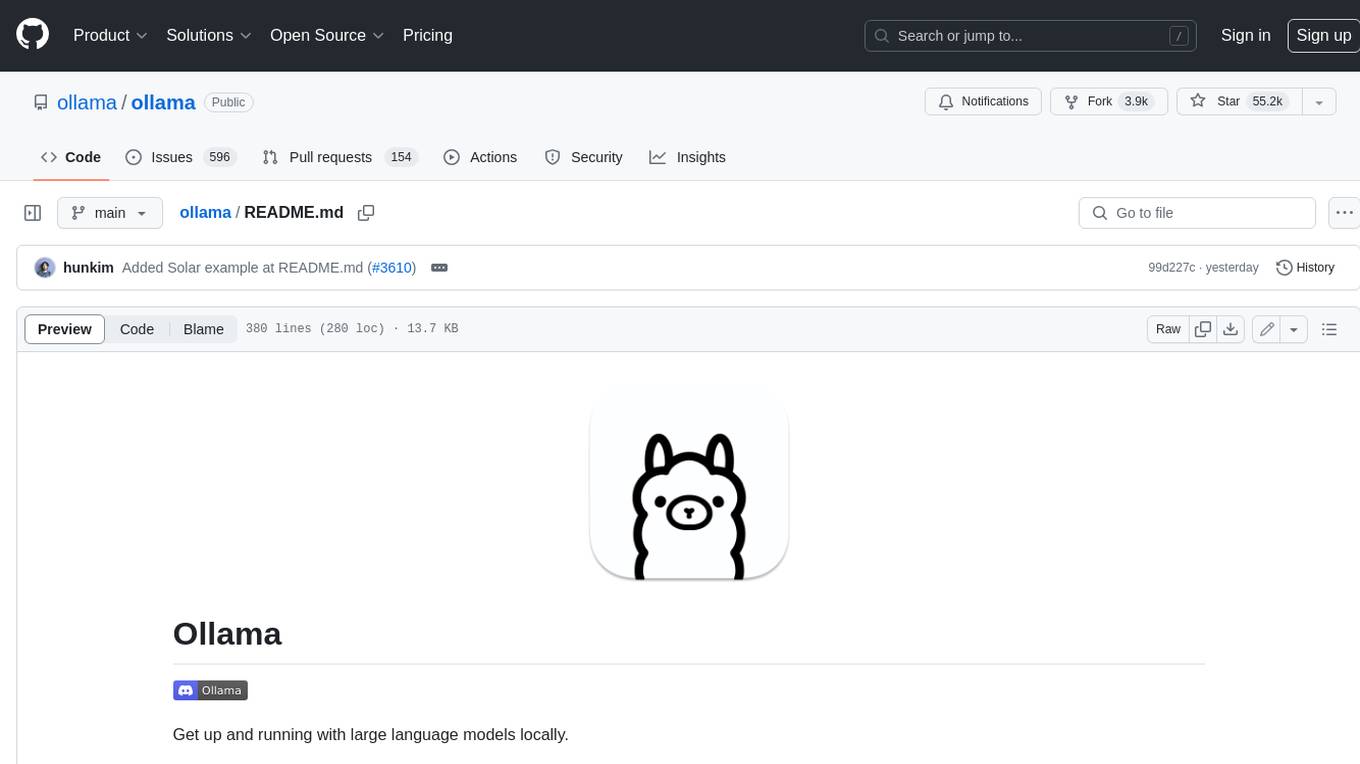
ollama
Ollama is a lightweight, extensible framework for building and running language models on the local machine. It provides a simple API for creating, running, and managing models, as well as a library of pre-built models that can be easily used in a variety of applications. Ollama is designed to be easy to use and accessible to developers of all levels. It is open source and available for free on GitHub.
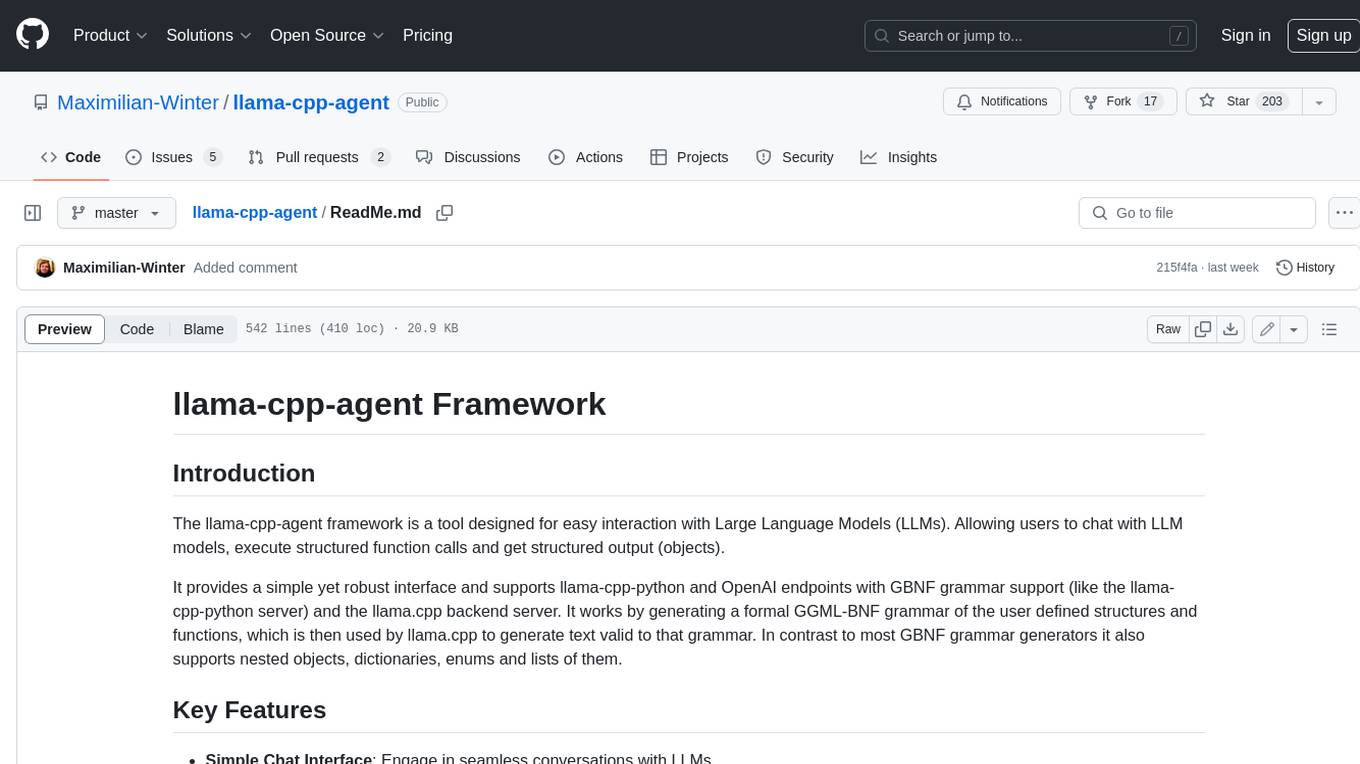
llama-cpp-agent
The llama-cpp-agent framework is a tool designed for easy interaction with Large Language Models (LLMs). Allowing users to chat with LLM models, execute structured function calls and get structured output (objects). It provides a simple yet robust interface and supports llama-cpp-python and OpenAI endpoints with GBNF grammar support (like the llama-cpp-python server) and the llama.cpp backend server. It works by generating a formal GGML-BNF grammar of the user defined structures and functions, which is then used by llama.cpp to generate text valid to that grammar. In contrast to most GBNF grammar generators it also supports nested objects, dictionaries, enums and lists of them.
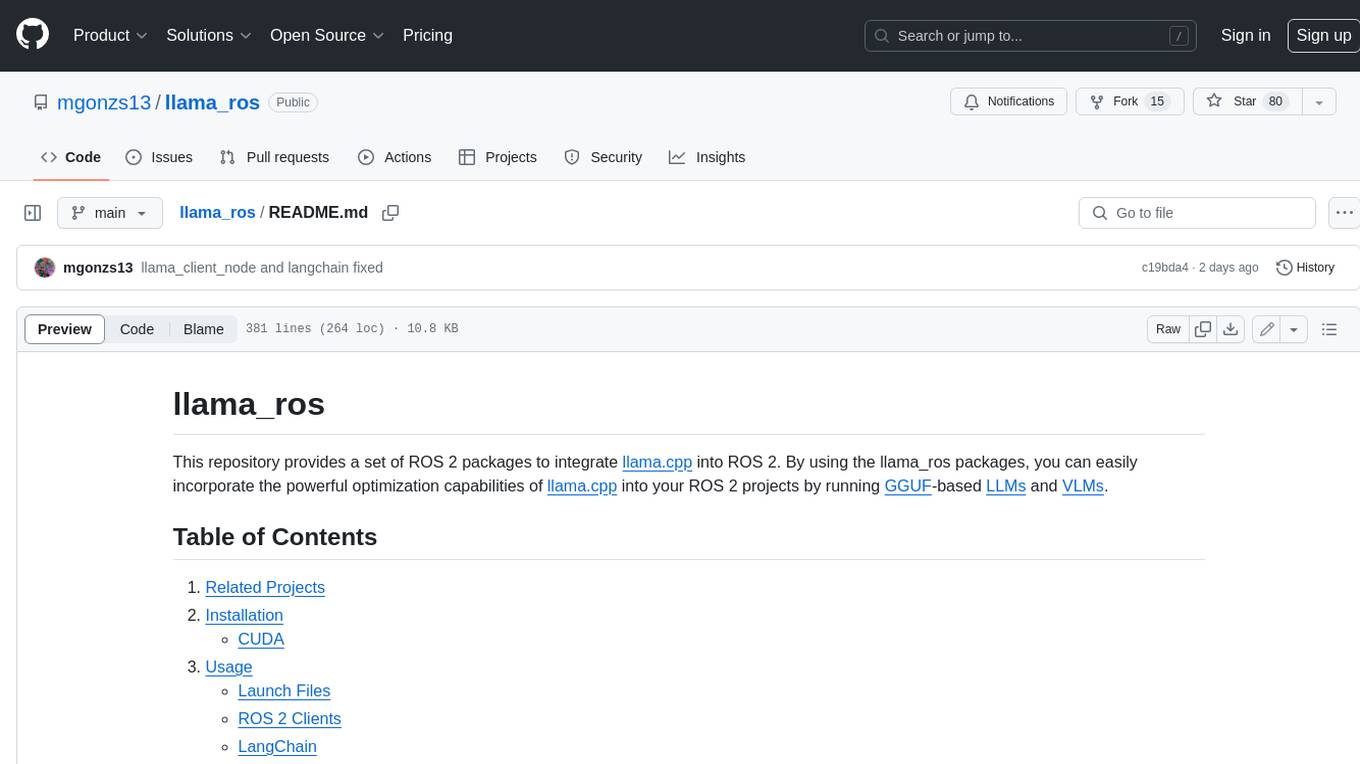
llama_ros
This repository provides a set of ROS 2 packages to integrate llama.cpp into ROS 2. By using the llama_ros packages, you can easily incorporate the powerful optimization capabilities of llama.cpp into your ROS 2 projects by running GGUF-based LLMs and VLMs.
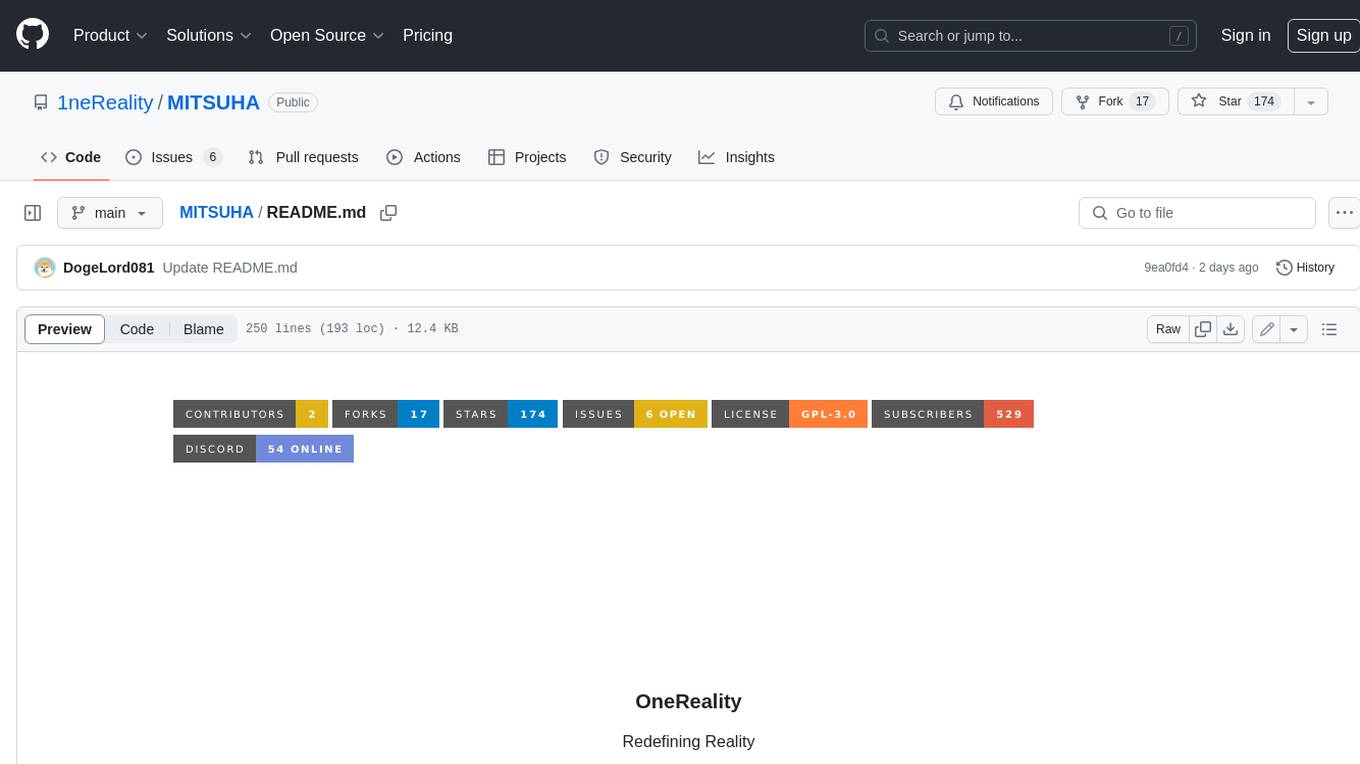
MITSUHA
OneReality is a virtual waifu/assistant that you can speak to through your mic and it'll speak back to you! It has many features such as: * You can speak to her with a mic * It can speak back to you * Has short-term memory and long-term memory * Can open apps * Smarter than you * Fluent in English, Japanese, Korean, and Chinese * Can control your smart home like Alexa if you set up Tuya (more info in Prerequisites) It is built with Python, Llama-cpp-python, Whisper, SpeechRecognition, PocketSphinx, VITS-fast-fine-tuning, VITS-simple-api, HyperDB, Sentence Transformers, and Tuya Cloud IoT.
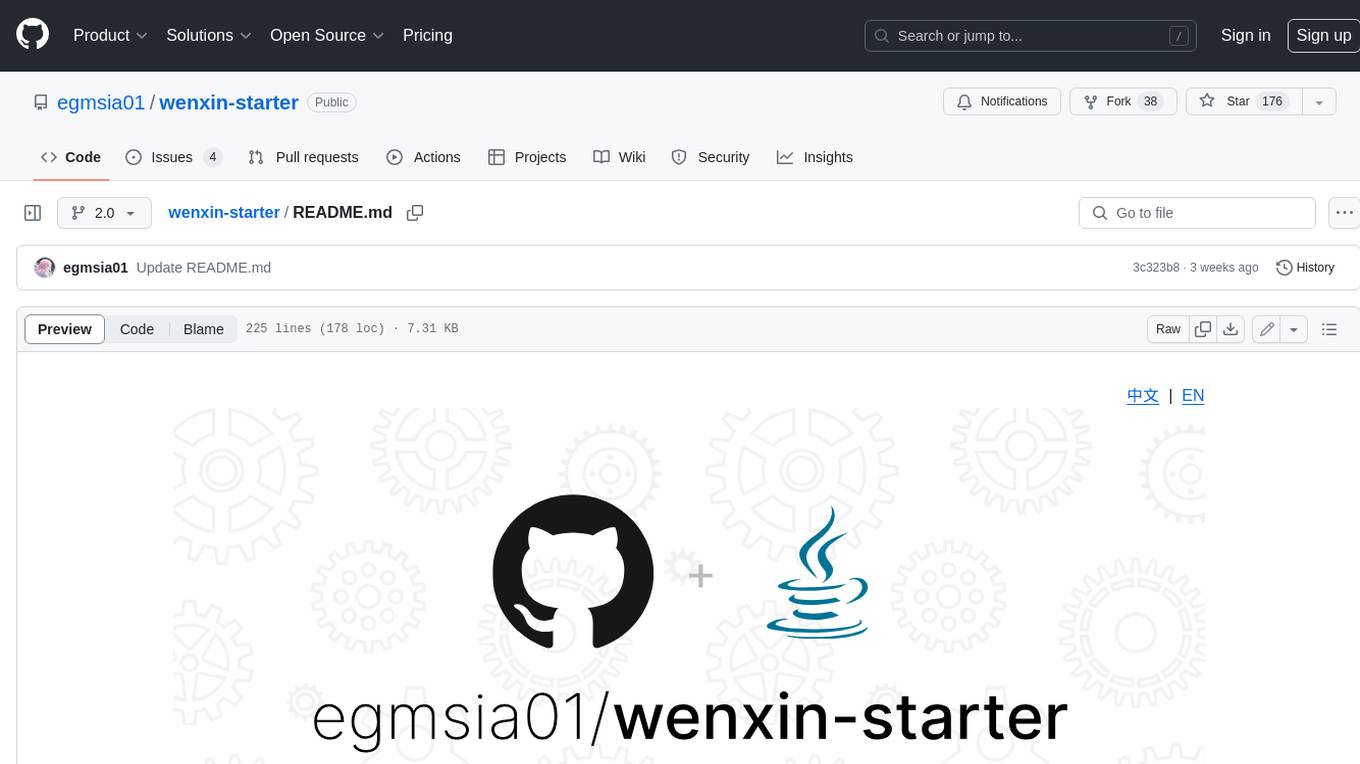
wenxin-starter
WenXin-Starter is a spring-boot-starter for Baidu's "Wenxin Qianfan WENXINWORKSHOP" large model, which can help you quickly access Baidu's AI capabilities. It fully integrates the official API documentation of Wenxin Qianfan. Supports text-to-image generation, built-in dialogue memory, and supports streaming return of dialogue. Supports QPS control of a single model and supports queuing mechanism. Plugins will be added soon.
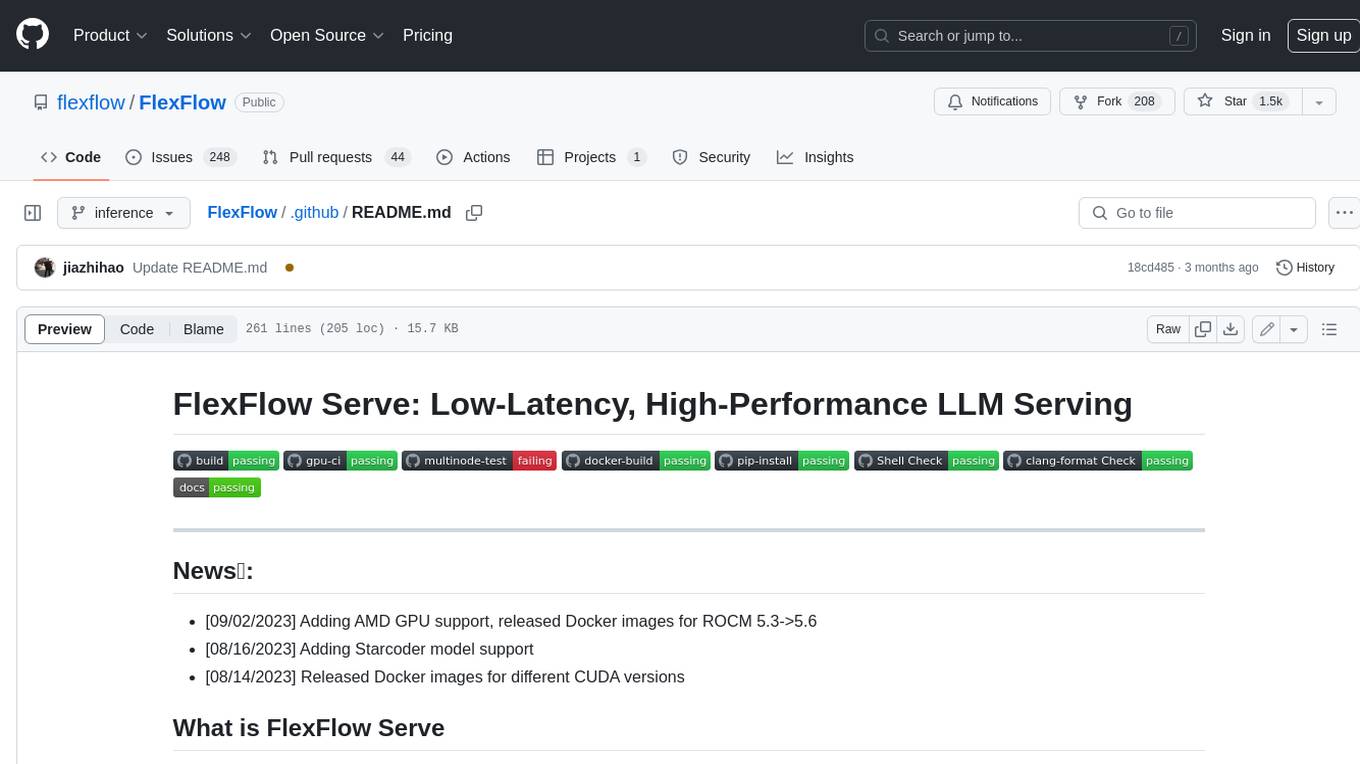
FlexFlow
FlexFlow Serve is an open-source compiler and distributed system for **low latency**, **high performance** LLM serving. FlexFlow Serve outperforms existing systems by 1.3-2.0x for single-node, multi-GPU inference and by 1.4-2.4x for multi-node, multi-GPU inference.



